JSR107
Java Caching定义了5个核心接口,分别是CachingProvider, CacheManager, Cache, Entry 和 Expiry。
CachingProvider:定义了创建、配置、获取、管理和控制多个CacheManager。一个应用可
以在运行期访问多个CachingProvider。CacheManager定义了创建、配置、获取、管理和控制多个唯一命名的Cache,这些Cache
存在于CacheManager的上下文中。一个CacheManager仅被一个CachingProvider所拥有。Cache是一个类似Map的数据结构并临时存储以Key为索引的值。一个Cache仅被一个
CacheManager所拥有。Entry 是一个存储在Cache中的key-value对。
Expiry 每一个存储在Cache中的条目有一个定义的有效期。一旦超过这个时间,条目为过期
的状态。一旦过期,条目将不可访问、更新和删除。缓存有效期可以通过ExpiryPolicy设置。
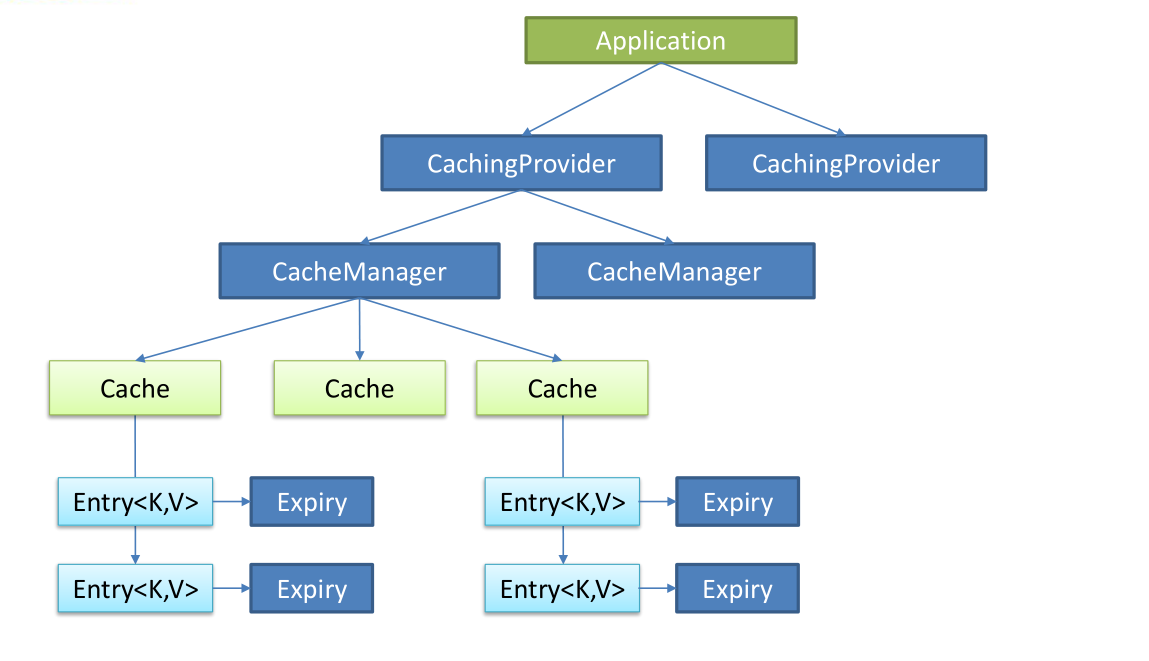
JSR107:定义的缓存规范,比较复杂,一般我们很少使用,接下来我们看看Spring的缓存抽象。
Spring缓存抽象
Spring从3.1开始定义了org.springframework.cache.Cache和org.springframework.cache.CacheManager接口来统一不同的缓存技术;并支持使用JCache(JSR-107)注解简化我们开发;
Cache接口为缓存的组件规范定义,包含缓存的各种操作集合;
Cache接口下Spring提供了各种xxxCache的实现;如RedisCache,EhCacheCache,ConcurrentMapCache等;
每次调用需要缓存功能的方法时,Spring会检查检查指定参数的指定的目标方法是否已经被调用过;如果有就直接从缓存中获取方法调用后的结果,如果没有就调用方法并缓存结果后返回给用户。下次调用直接从缓存中获取。
使用Spring缓存抽象时我们需要关注以下两点;
1.确定方法需要被缓存以及他们的缓存策略
2.从缓存中读取之前缓存存储的数据

几个重要概念&缓存注解
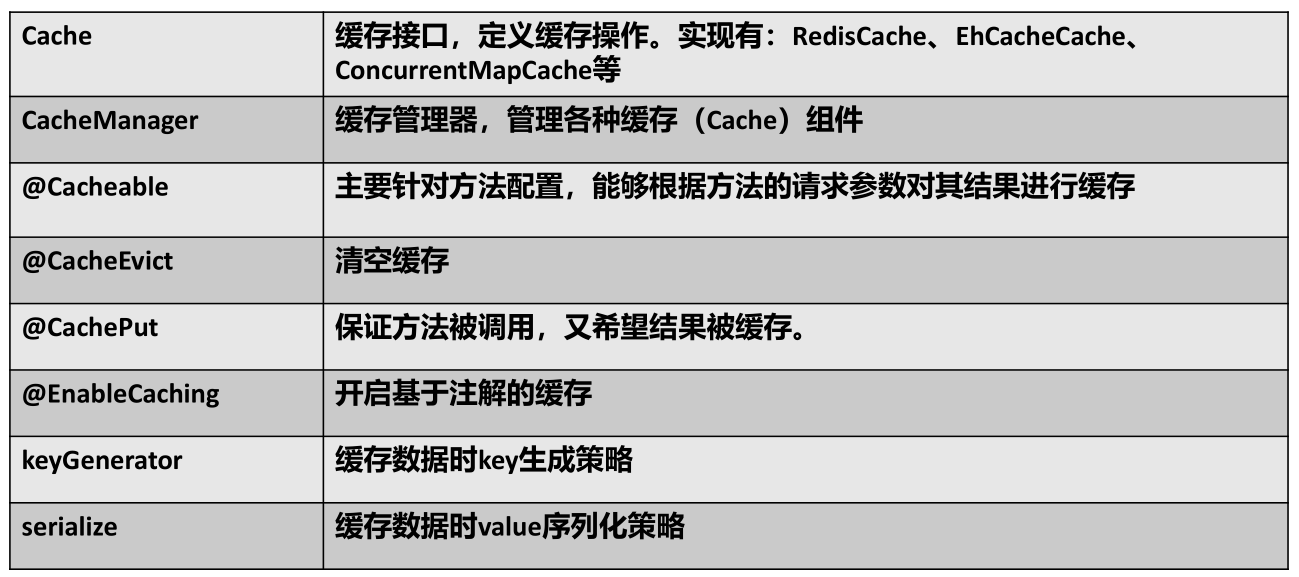

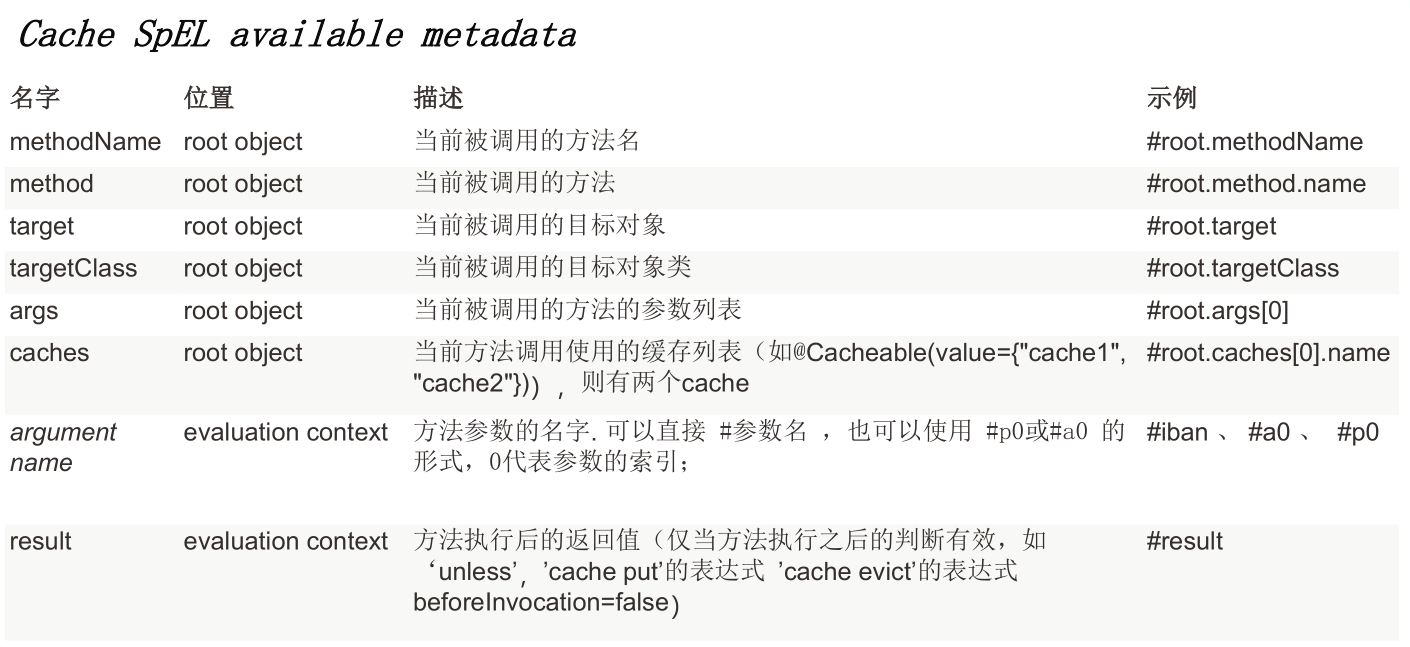
缓存使用
引入spring-boot-starter-cache模块
@EnableCaching开启缓存
使用缓存注解
切换为其他缓存
搭建基本环境
1)导入数据库文件,创建出department和employee表:
打开Navicat:mysql客户端。创建本地的数据库spring_cache

将spring_cache.sql文件导入到spring_cache数据库中
spring_cache.sql:
SET FOREIGN_KEY_CHECKS=0;
-- ----------------------------
-- Table structure for department
-- ----------------------------
DROP TABLE IF EXISTS `department`;
CREATE TABLE `department` (
`id` int(11) NOT NULL AUTO_INCREMENT,
`departmentName` varchar(255) DEFAULT NULL,
PRIMARY KEY (`id`)
) ENGINE=InnoDB DEFAULT CHARSET=utf8;
-- ----------------------------
-- Table structure for employee
-- ----------------------------
DROP TABLE IF EXISTS `employee`;
CREATE TABLE `employee` (
`id` int(11) NOT NULL AUTO_INCREMENT,
`lastName` varchar(255) DEFAULT NULL,
`email` varchar(255) DEFAULT NULL,
`gender` int(2) DEFAULT NULL,
`d_id` int(11) DEFAULT NULL,
PRIMARY KEY (`id`)
) ENGINE=InnoDB DEFAULT CHARSET=utf8;
导入成功后,会生成 department和employee表。(大家实在不会,手动创建也行)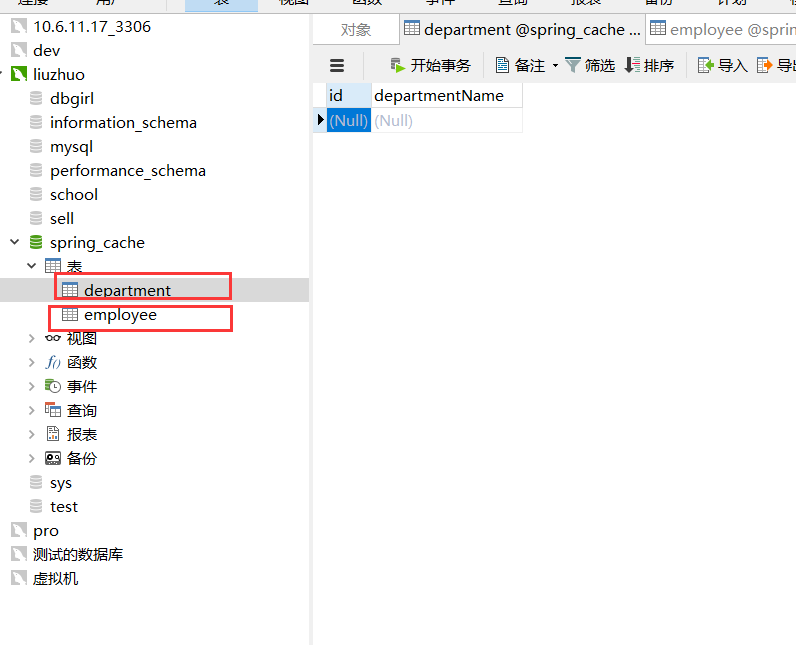
2)打开idea创建Springboot项目。选择cache、web、mysql、mybatis模块
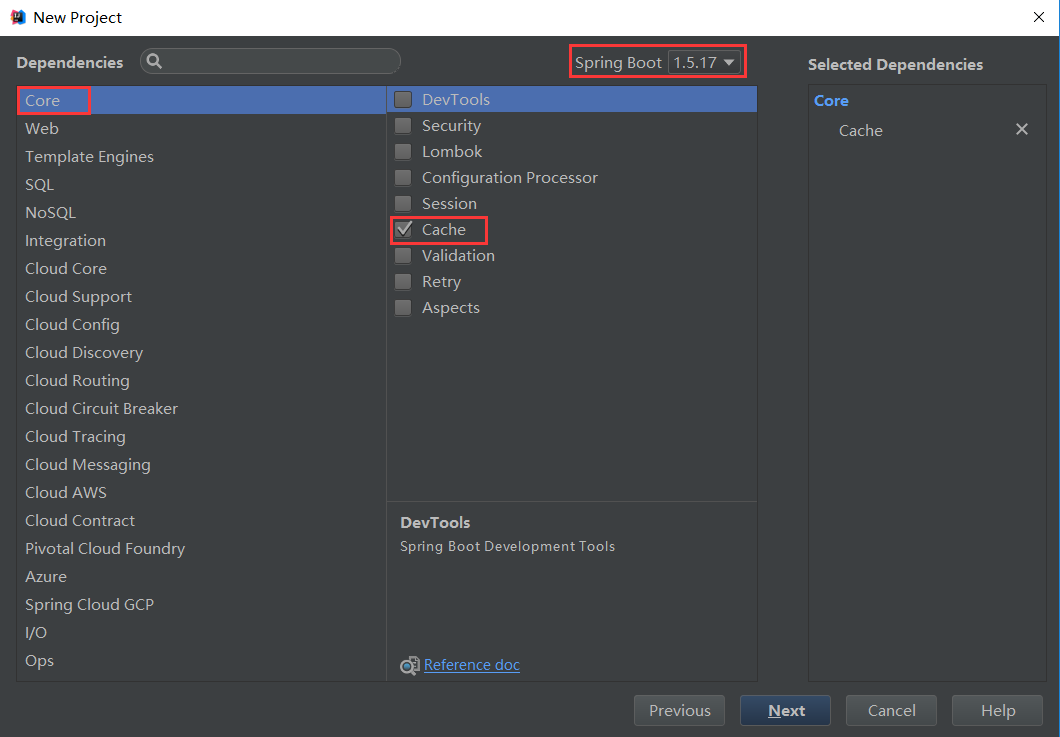
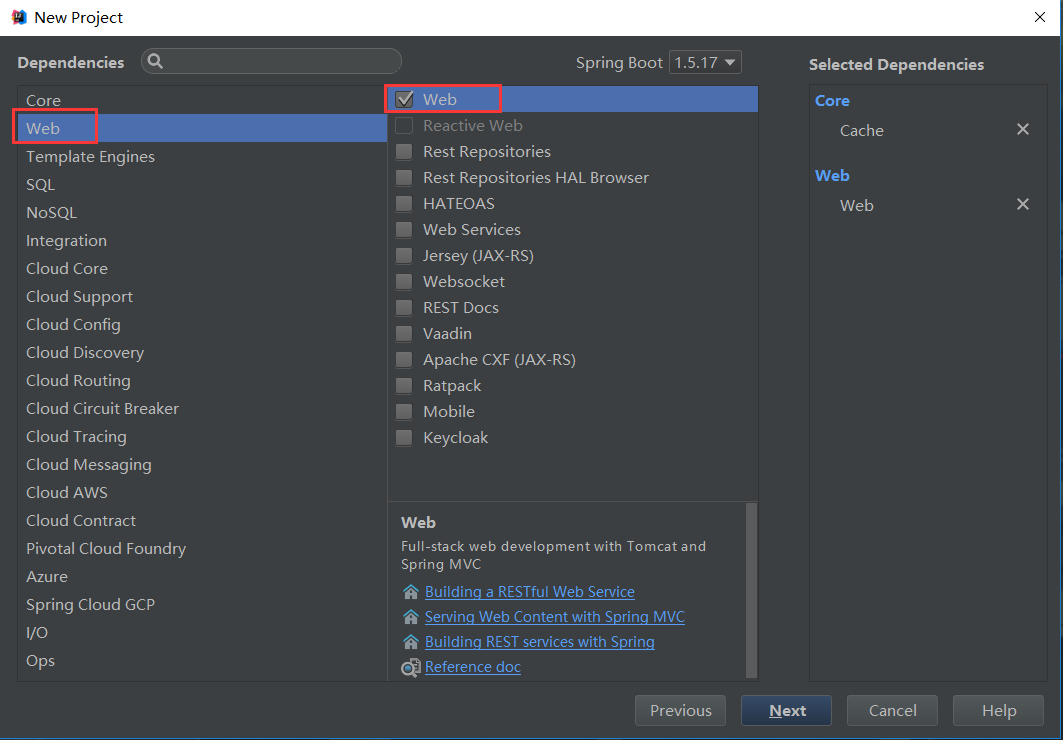
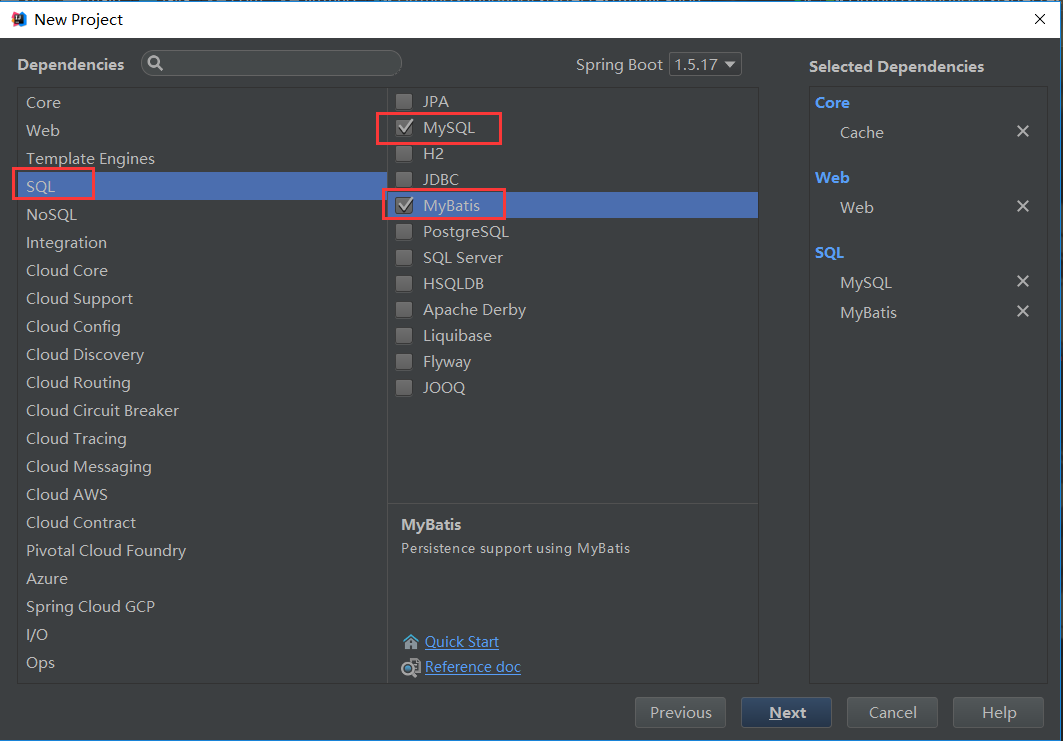
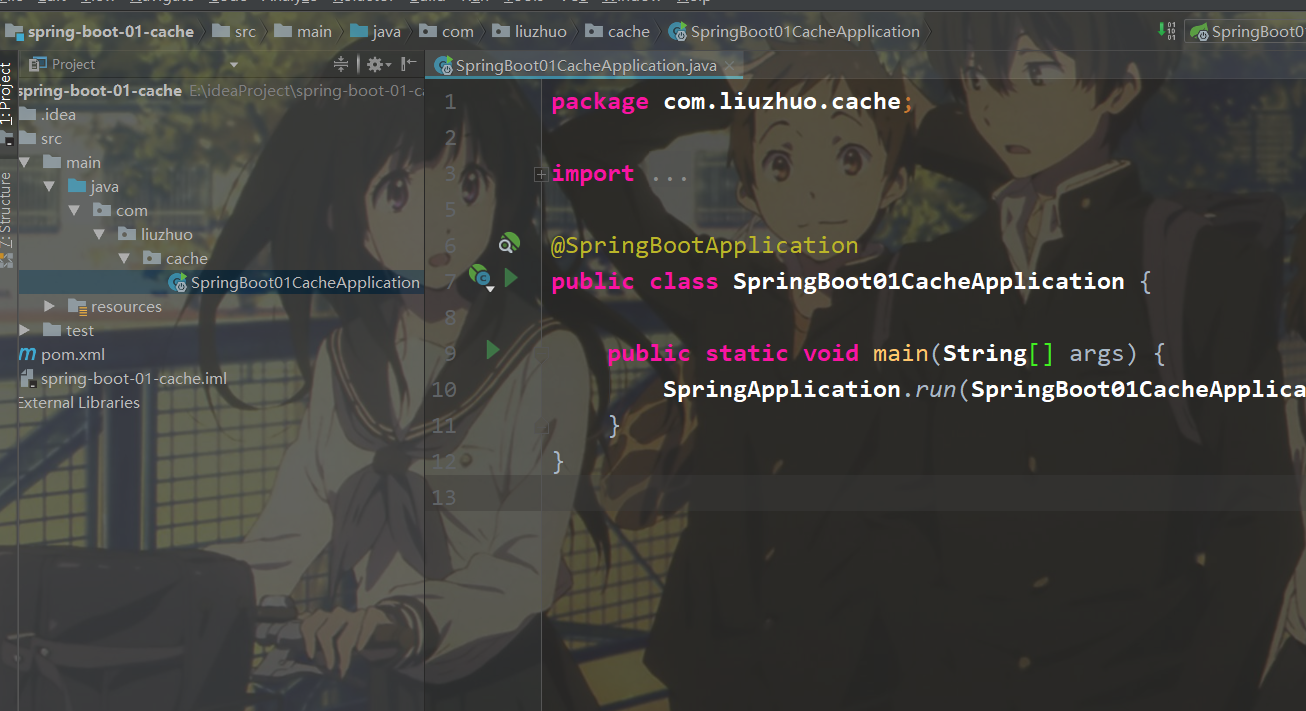
3)创建对应的 javaBean对象:( department 和 employee )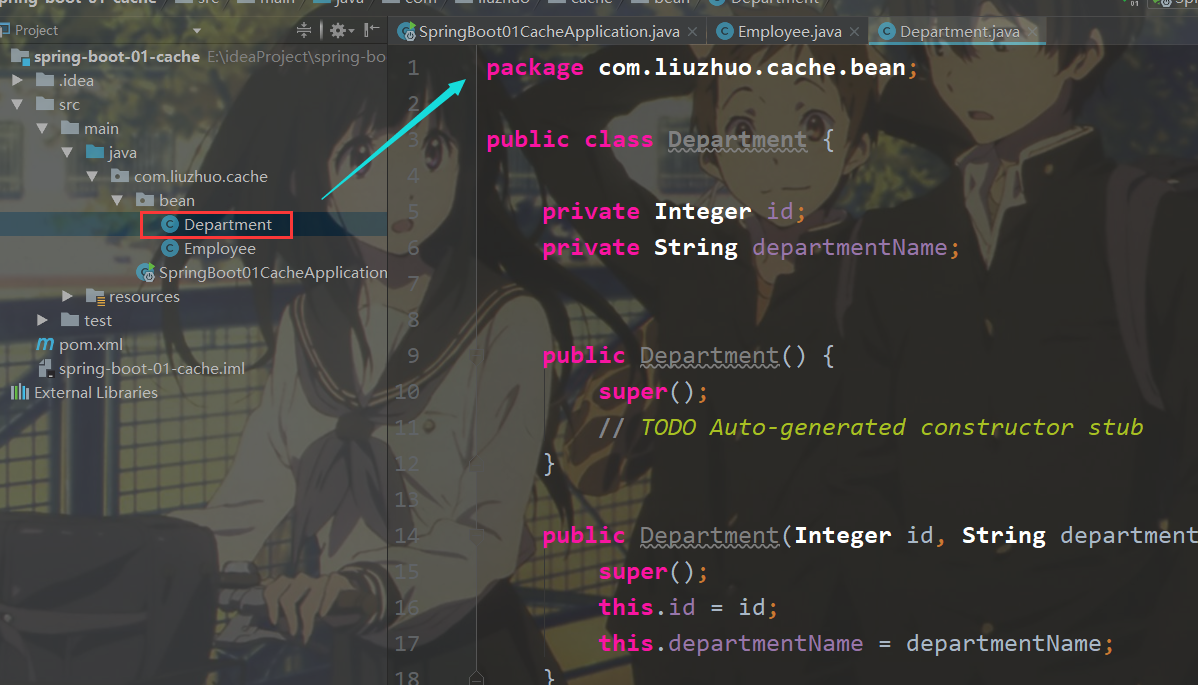
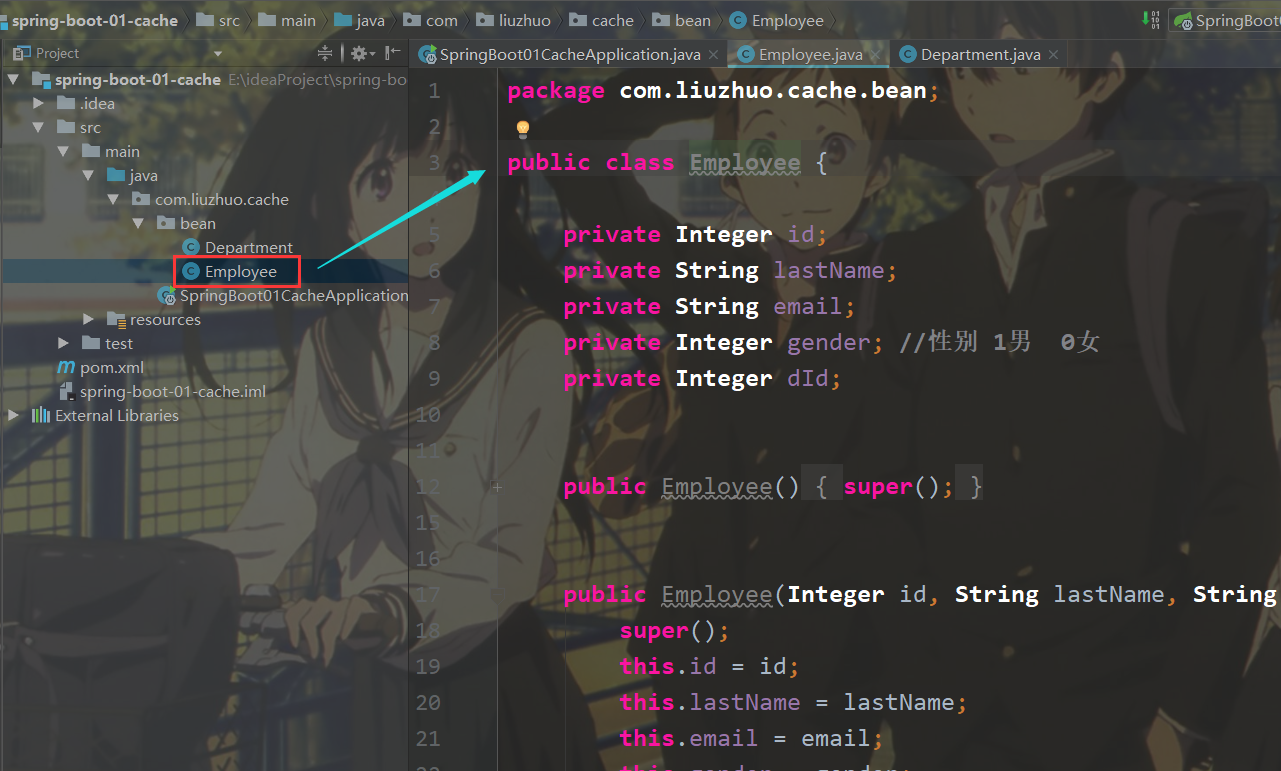
4)配置数据库信息
在application配置文件中: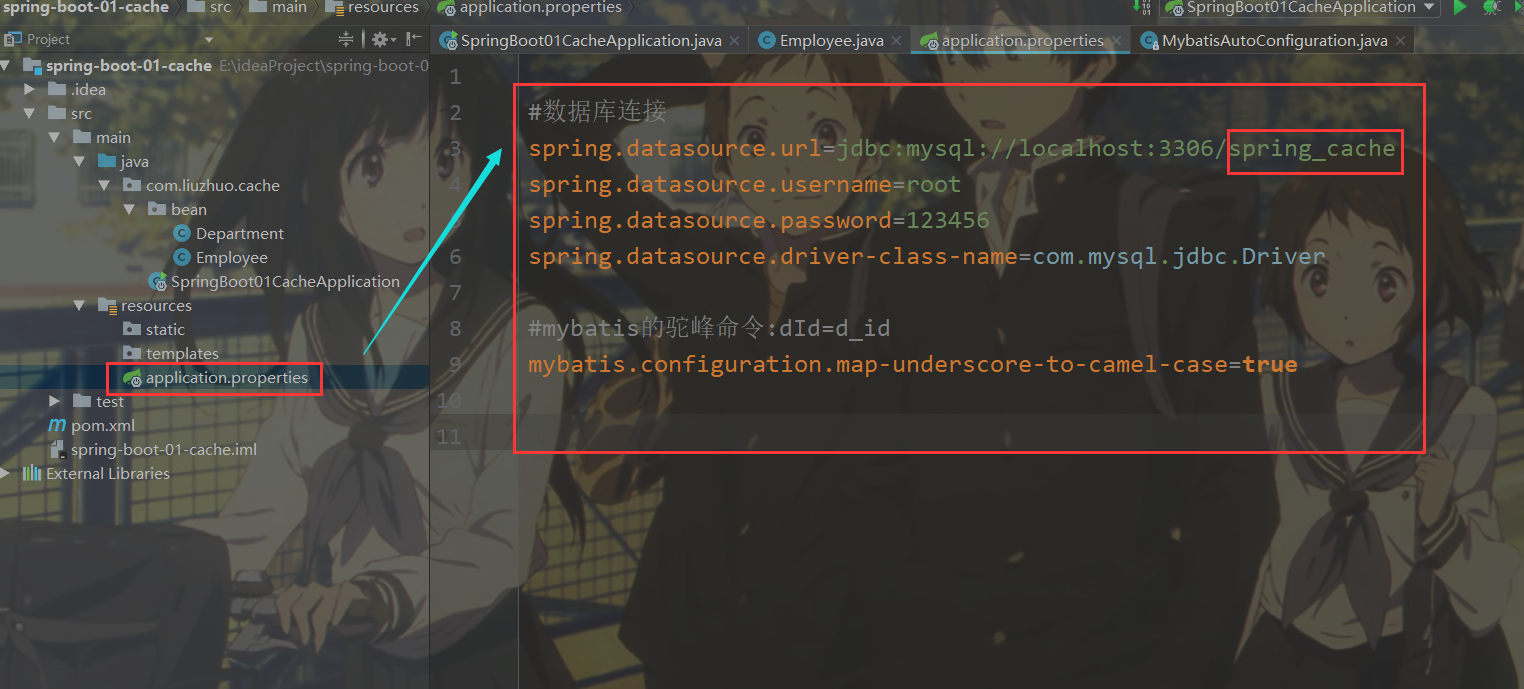
#数据库连接
spring.datasource.url=jdbc:mysql://localhost:3306/spring_cache
spring.datasource.username=root
spring.datasource.password=123456
spring.datasource.driver-class-name=com.mysql.jdbc.Driver
#mybatis的驼峰命令:dId=d_id
mybatis.configuration.map-underscore-to-camel-case=true
5) 整合mybatis
创建mapper包:并创建 DepartmentMapper 和 EmployeeMapper
如果不清楚Mybatis与Springboot的整合,去看Springboot的基础里面的数据部分。Mybatis整合
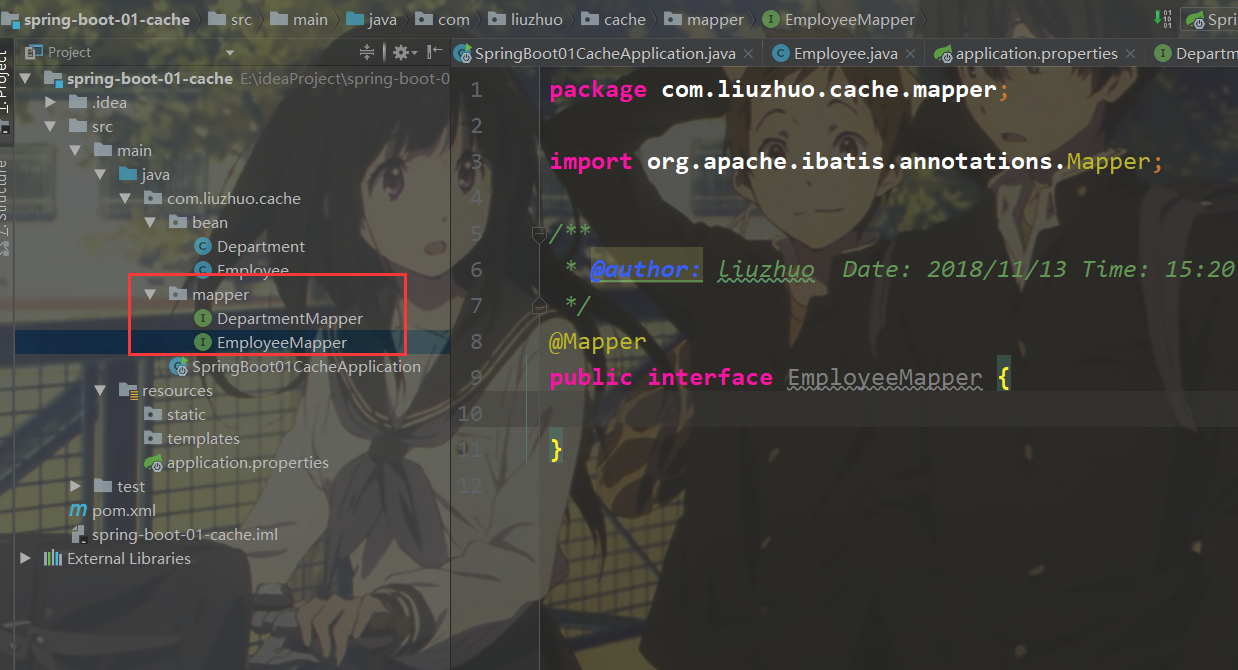
@Mapper
public interface EmployeeMapper {
//获取Employee对象
@Select("select * from employee where id =#{id}")
public Employee getEmployeeById(Integer id);
//更新Employee对象
@Update("update employee set lastName=#{lastName},email=#{email},gender=#{gender},d_id=#{dId} where id=#{id}")
public Employee updateEmployee(Employee employee);
//删除employee对象
@Delete("delete from employee where id=#{id}")
public void deleteEmployeeById(Integer id);
//增加employee对象
@Insert("insert into employee(lastName,email,gender,d_id) values(#{lastName},#{email},#{gender},#{dId})")
public void insertEmployee(Employee employee);
}
6) 编写service和controller层:
EmployeeService: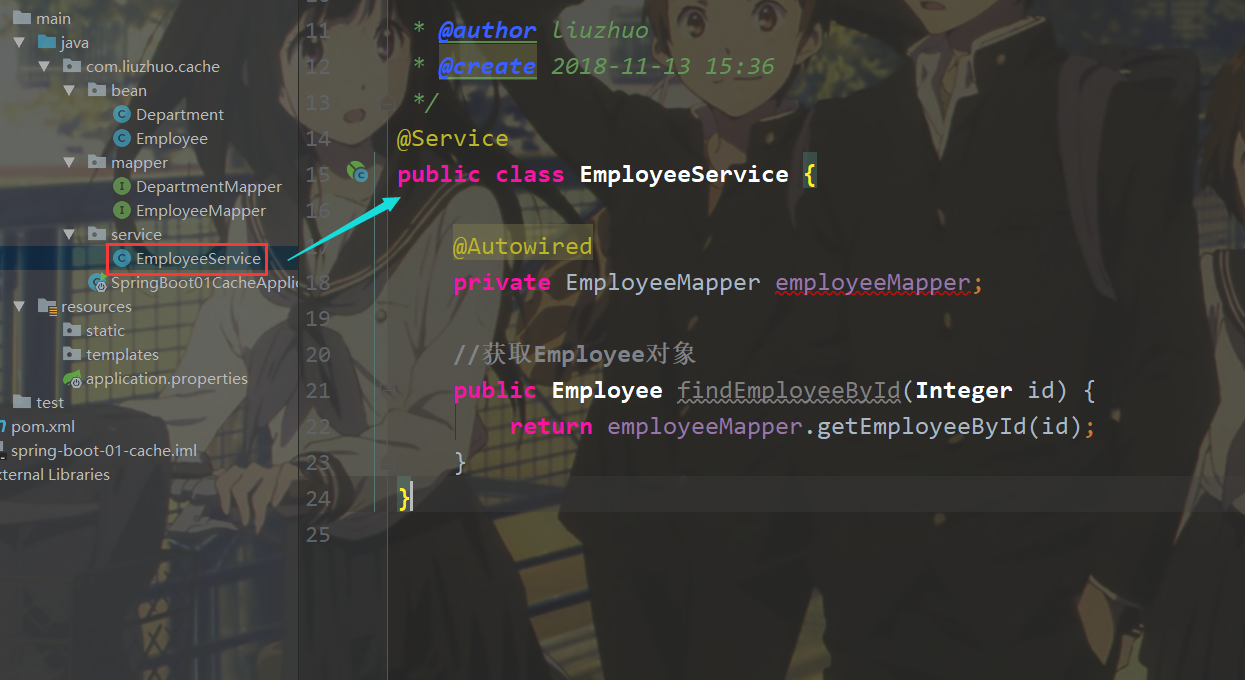
EmployeeController: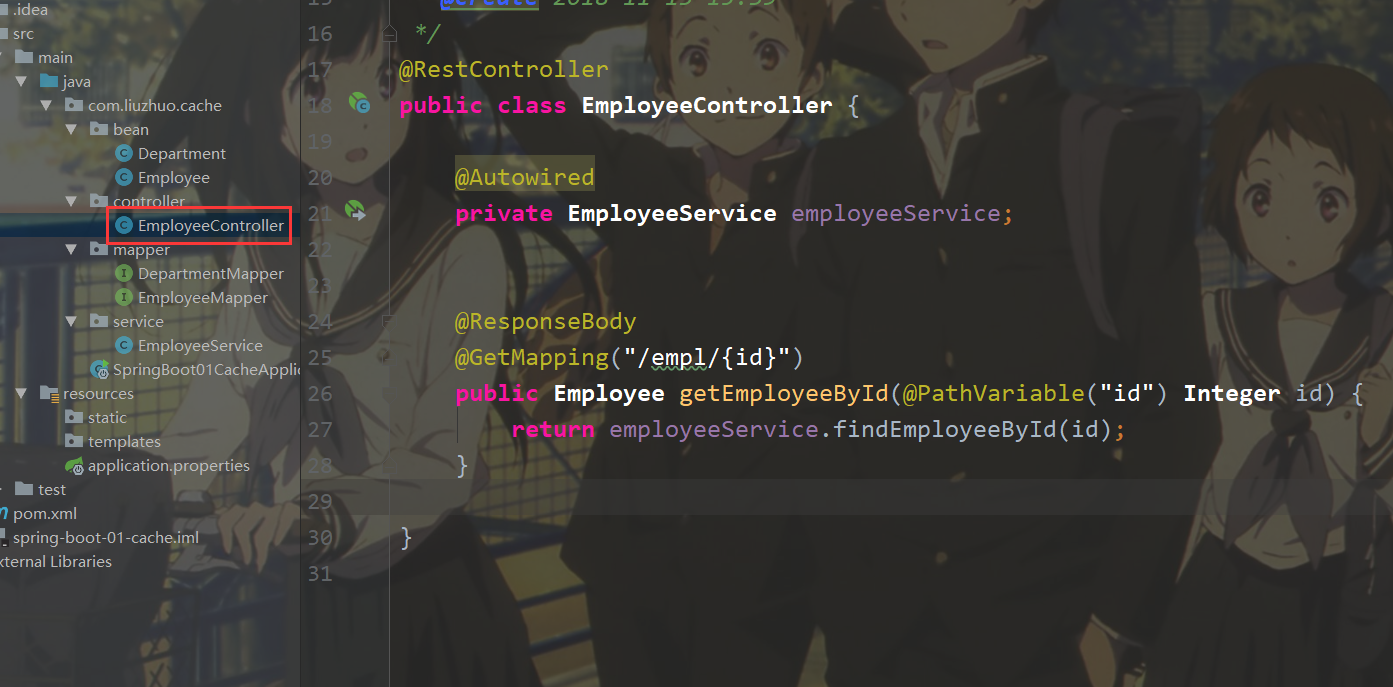
7)启动应用,验证我们的应用是否成功:
然后在我们的数据库中,随便手动插入一条数据:
在浏览器中输入:http://localhost:8080/empl/1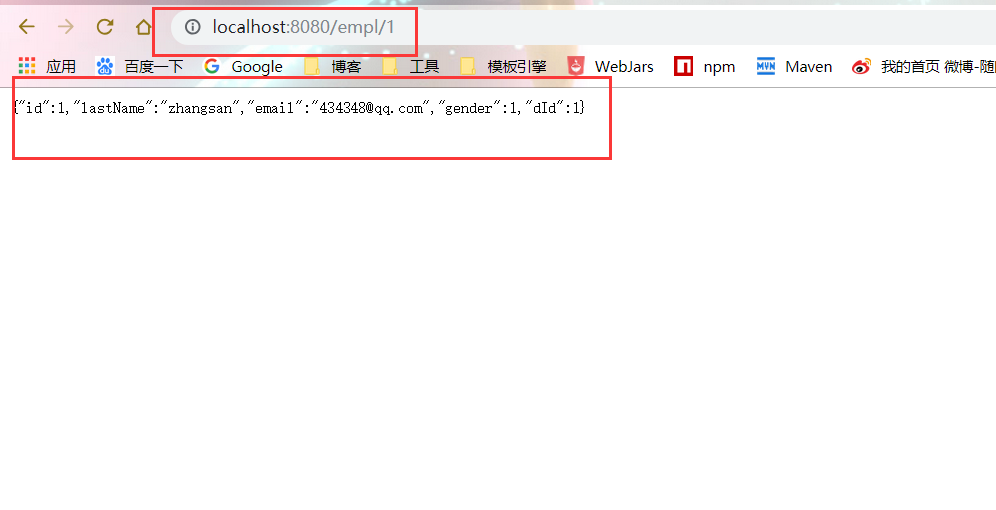
PS:如果控制台出现Establishing SSL警告:是因为在MYSQL5.5.45+, 5.6.26+ and 5.7.6+版本中需要携带服务器身份验证的SSL连接。
解决办法:
1)在数据库连接的url中添加useSSL=false;(不使用ssl连接)
2)url中添加useSSL=true,并且提供服务器的验证证书。
我们这里就直接不使用了,在url后面加上?useSSL=false即可。spring.datasource.url=jdbc:mysql://localhost:3306/spring_cache?useSSL=false
缓存的快速体验
步骤:
1)开启缓存的注解,@EnableCaching
2)使用缓存的注解来添加缓存的功能
在没有使用缓存的时候,每次发送请求都会到数据库中,查询数据:
现在,给EmployeeService添加输出语句:
修改日志的级别:
logging.level.com.liuzhuo.cache=debug
启动Springboot应用:在浏览器中输入:http://localhost:8080/empl/1

刷新页面,还是会打印出 输出语句 和 sql的查询信息。
使用缓存:
1)给启动类上面,加上@EnableCaching
2)给 EmployeeService 中 findEmployeeById 方法添加缓存的注解:( @Cacheable )
@Service
public class EmployeeService {
@Autowired
private EmployeeMapper employeeMapper;
//获取Employee对象
/**
* Cacheable:查询时候缓存,第一次会到数据库中查询数据,以后都只会到
* 缓存中获取数据。
* 几个重要的属性:
* 1)cacheName/value: 指定缓存组件的名字。
* 2)key:缓存数据使用的key。默认是使用方法参数的值,比如这里id=1的话,默认key=1
* 可以使用SpEl表达式:#id获取的参数的值,#a0 #p0都是获取第一个参数的值
* #root.args[0]:也是获取第一个参数的值
* 3)keyGenerator:key的生成器,可以自己指定key的生成器的组件的id
* key或keyGenerator:二选一
* 4) cacheManager:指定缓存管理器
* 5) cacheResolver:指定缓存解析器。和cacheManager二选一
* 6) condition:指定符合条件的情况下,才缓存数据.
* 可以使用SpEl表达式:condition="#id>5"
* 7) unless:否定缓存,与condition作用相反
* 8) sync:是否使用异步模式
*/
@Cacheable
public Employee findEmployeeById(Integer id) {
System.out.println("查询:"+id+"号的信息");
return employeeMapper.getEmployeeById(id);
}
}
3)启动SpringBoot应用:
在浏览器中输入:http://localhost:8080/empl/1
只有第一次会打印 输出语句。之后都不会打印输出语句,说明数据已经被缓存到缓存当中了。
SpringBoot的缓存原理:
1)打开CacheAutoConfiguration:

2)观察导入@Import(CacheConfigurationImportSelector.class)
3)CacheConfigurationImportSelector帮我们缓存了哪些类呢?
打上断点,debug一下: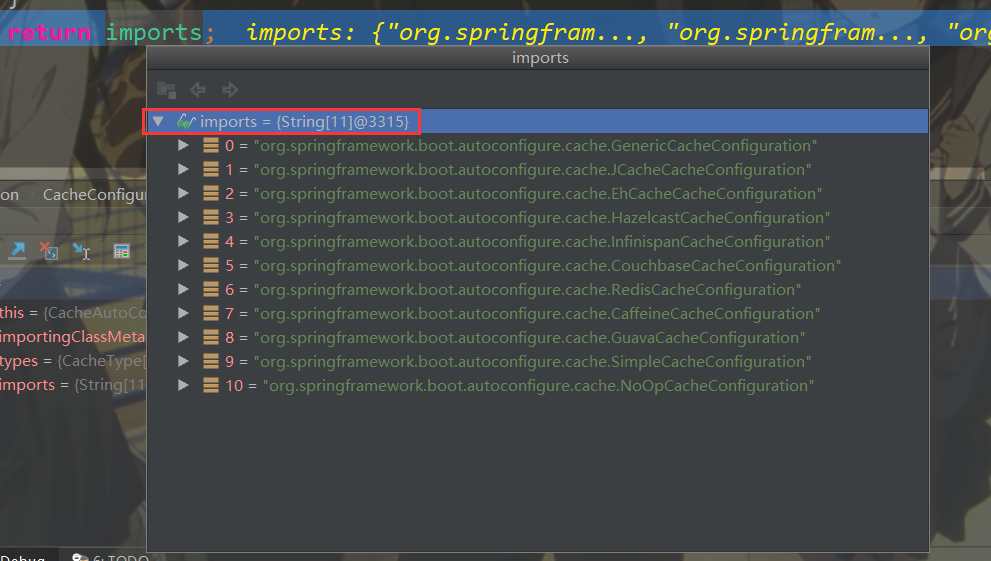
org.springframework.boot.autoconfigure.cache.GenericCacheConfiguration
org.springframework.boot.autoconfigure.cache.JCacheCacheConfiguration
org.springframework.boot.autoconfigure.cache.EhCacheCacheConfiguration
org.springframework.boot.autoconfigure.cache.HazelcastCacheConfiguration
org.springframework.boot.autoconfigure.cache.InfinispanCacheConfiguration
org.springframework.boot.autoconfigure.cache.CouchbaseCacheConfiguration
org.springframework.boot.autoconfigure.cache.RedisCacheConfiguration
org.springframework.boot.autoconfigure.cache.CaffeineCacheConfiguration
org.springframework.boot.autoconfigure.cache.GuavaCacheConfiguration
org.springframework.boot.autoconfigure.cache.SimpleCacheConfiguration
org.springframework.boot.autoconfigure.cache.NoOpCacheConfiguration
4)而注入的这里类,哪些会生效呢?
Application配置:debug=true.
发现:只有 SimpleCacheConfiguration 生效。
5)SimpleCacheConfiguration给容器中注入了一个cacheManager:ConcurrentMapCacheManager
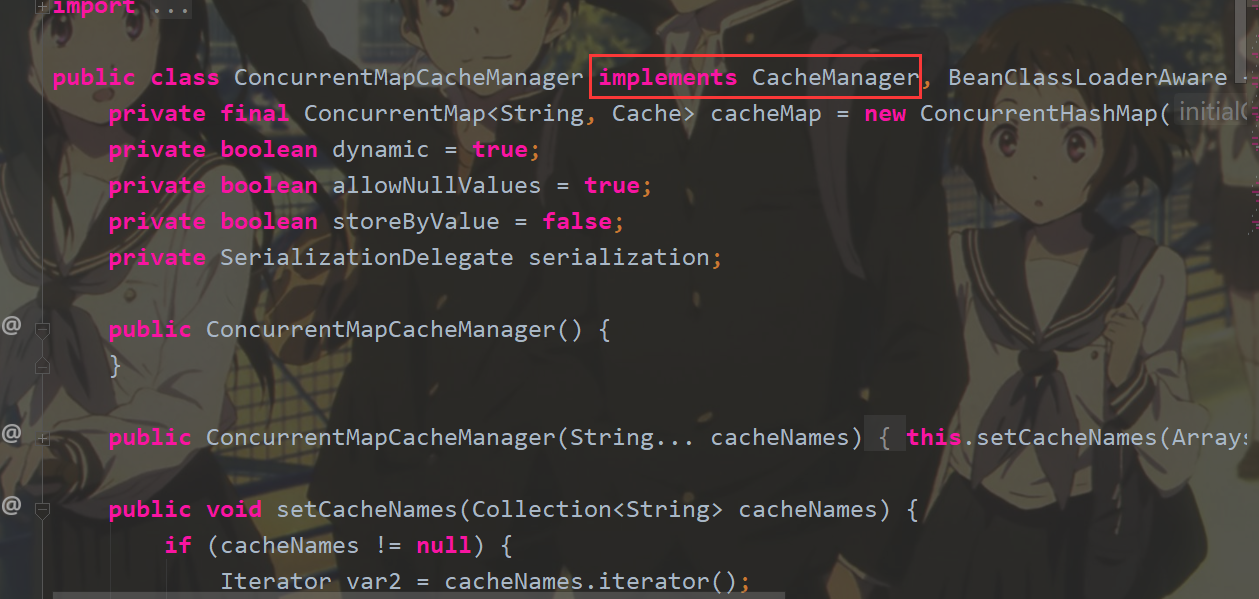
6)ConcurrentMapCacheManager:实质上就是一个ConcurrentHashMap。
然后使用ConcurrentMapCache(实质ConcurrentMap)将数据保存在ConcurrentMap中。
缓存的运行流程
给 EmployeeService 的 findEmployeeById 方法 打上断点:
给 ConcurrentMapCacheManager getCache 方法 打上断点: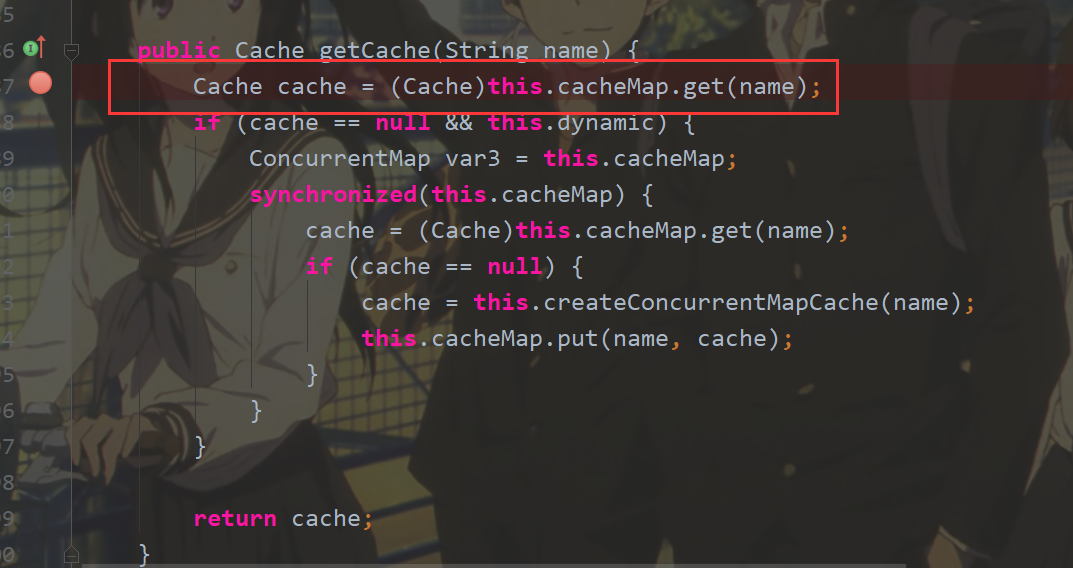
给 ConcurrentMapCache 的lookup、get、set 打上断点: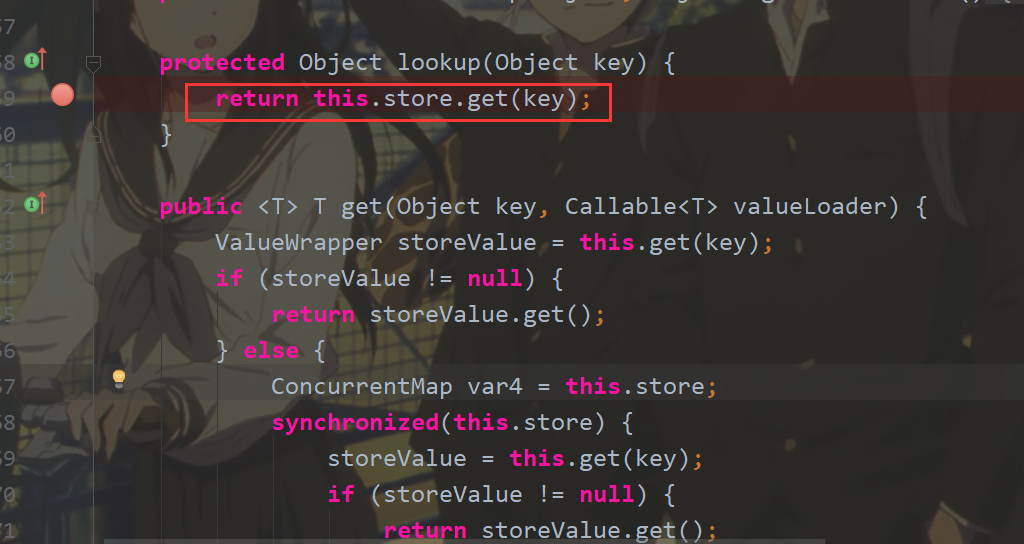
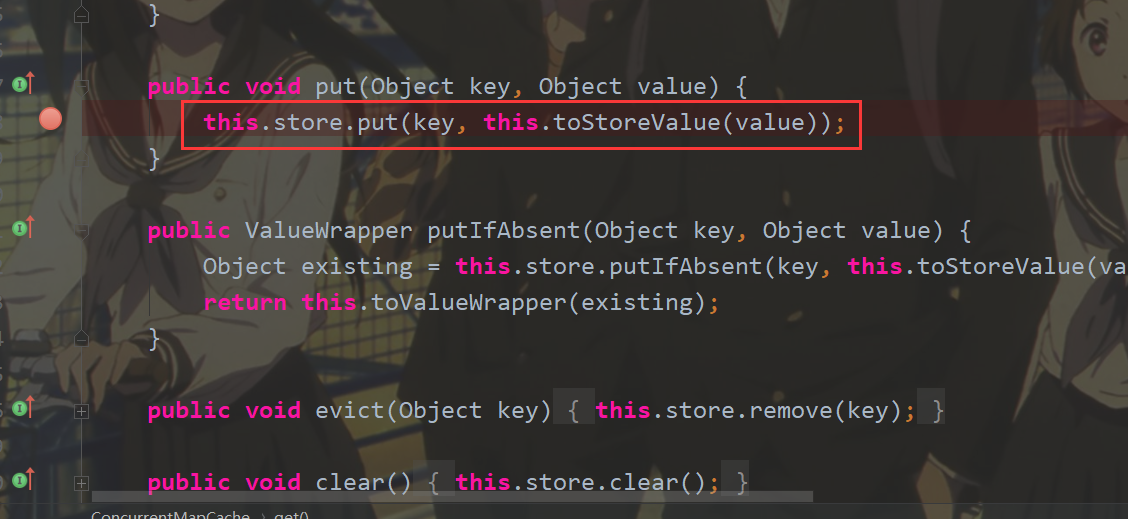
debug运行一下:
在浏览器中输入:http://localhost:8080/empl/1
进入断点处:
当首次进入该方法时,不会执行该方法,会先进入缓存中获取数据
根据 cacheNames/value 来获取cache。
这里 cacheNames=’empl’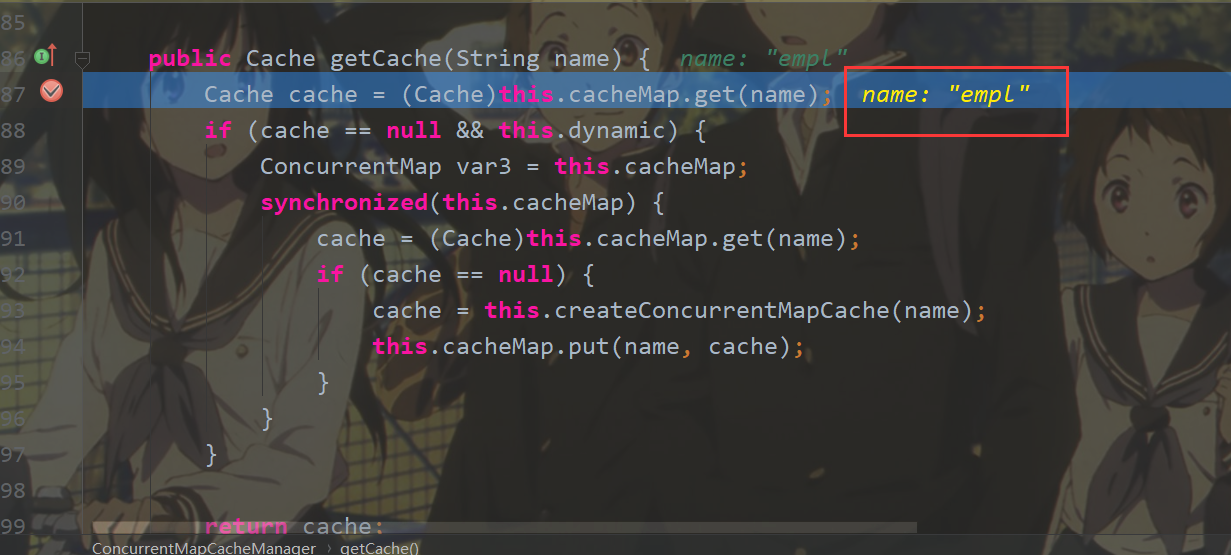
第一次查询,名称为empl的’cache’一定是null,所以会创建名称为’empl’的cache

创建’empl’的cache成功后,这里的cache就是ConcurrentMapCache,放到ConcurrentMapCacheManager中。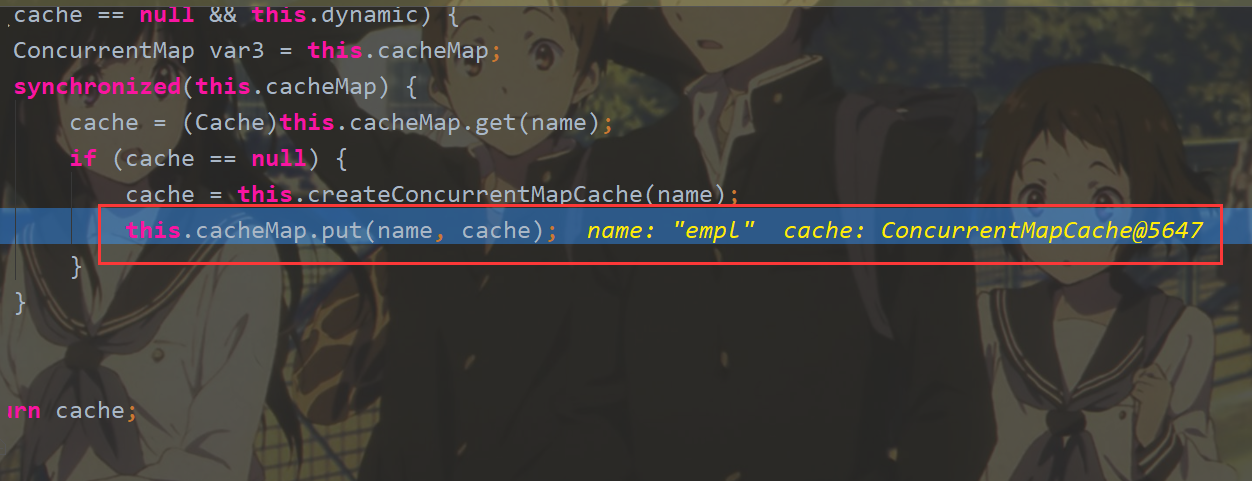
然后在ConcurrentMapCache中,寻找key等于我们默认参数值的value值: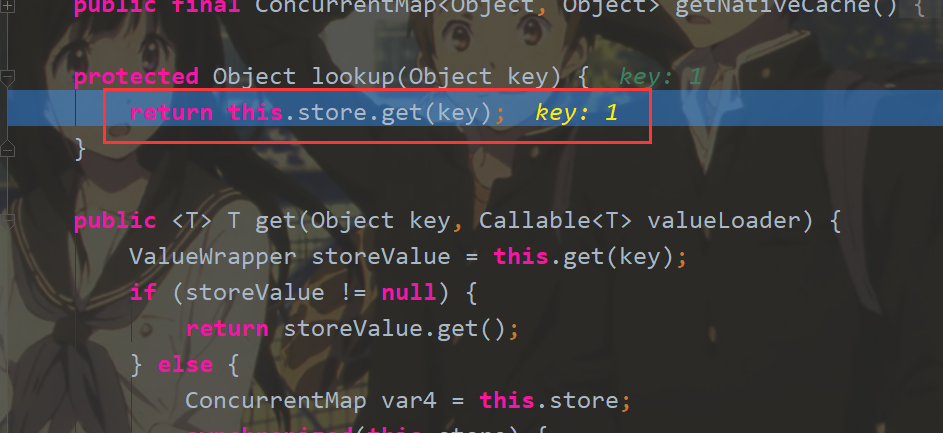
没有找key=1的缓存值,所以执行 findEmployeeById 方法: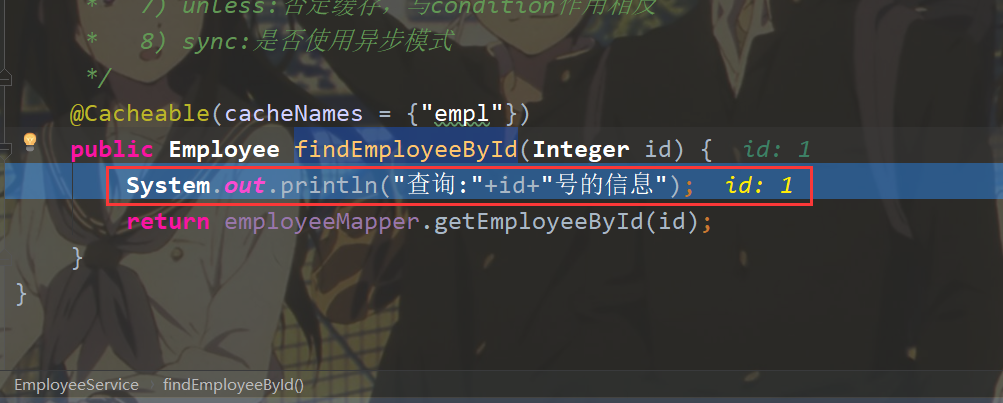
从数据库中获取数据,将数据放到缓存当中。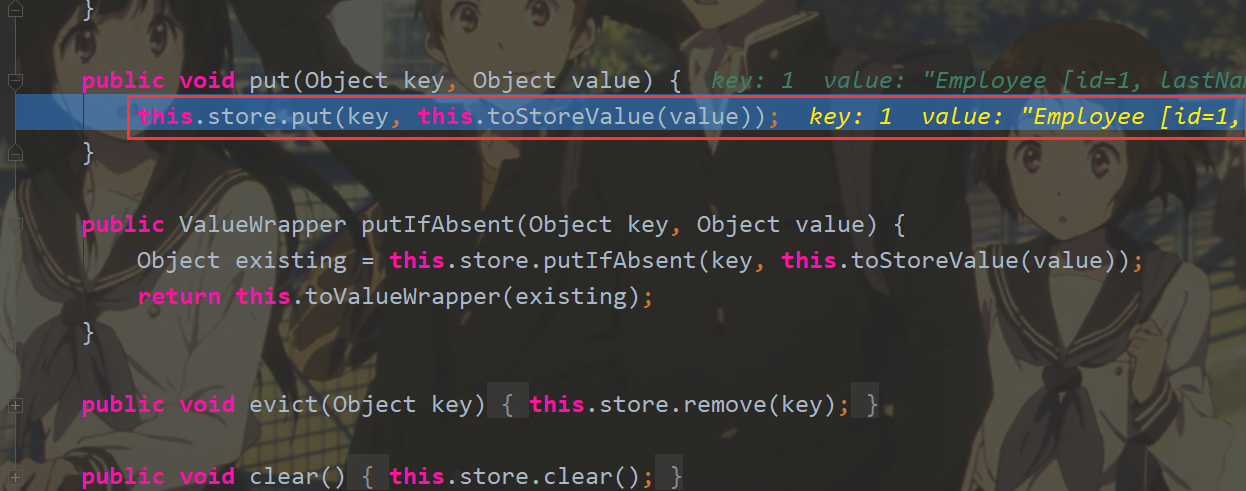
当再次,刷新页面时。
name=’empl’的cache已经存在了
然后在name=’empl’的cache中寻找key=1的缓存: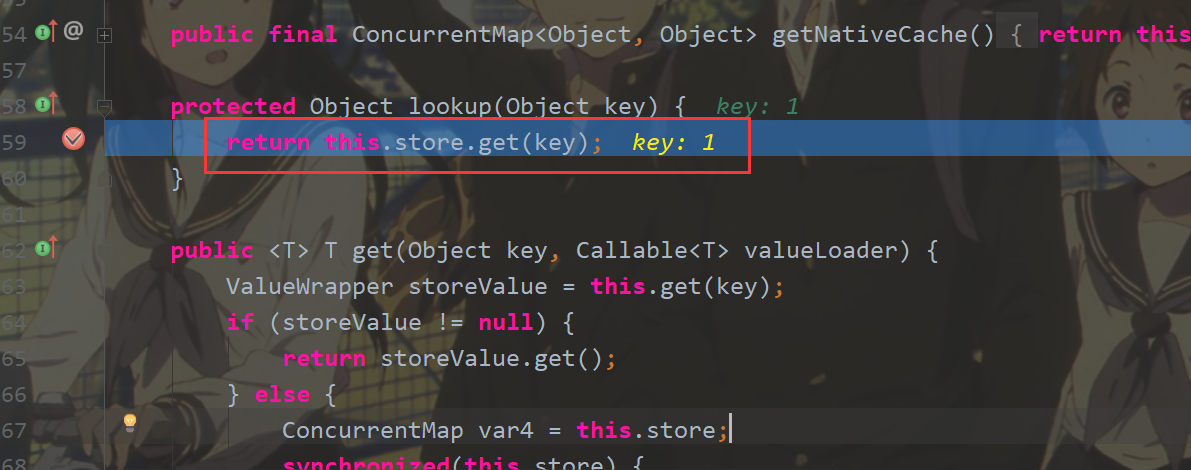
然后直接就找到了key=1的缓存了,直接返回对象,不在执行 findEmployeeById 方法了。
直接来了到控制层,return语句,返回视图。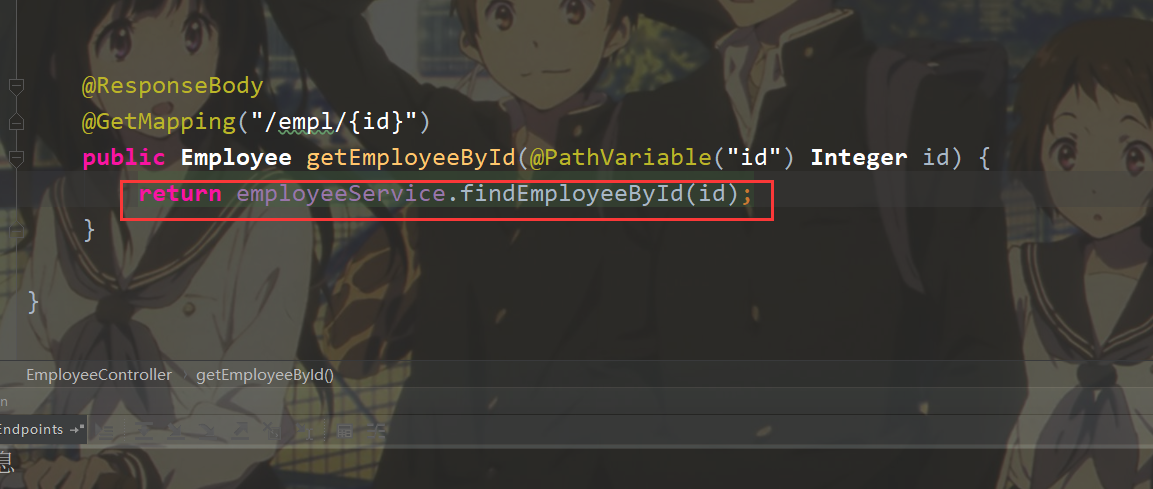
总结:@cacheable标注的方法执行之前,先来检查缓存中有么有我们的定义的name的cache缓存,按照默认的key生成策略的值去查询对应的缓存,如果没有就运行该方法,并放入缓存中。以后调用就直接使用缓存中的数据。
核心:
1)使用cacheManager[ConcurrentMapCacheManager]按照名字name来获取cache[ConcurrentMapCache]组件
2)key使用keyGenerator生成的,默认是SimpleGenerator。
3)cache使用生成的key来获取缓存或者放入缓存当中。
@Cacheable属性的使用
1)cacheNames/value: 指定缓存组件的名字。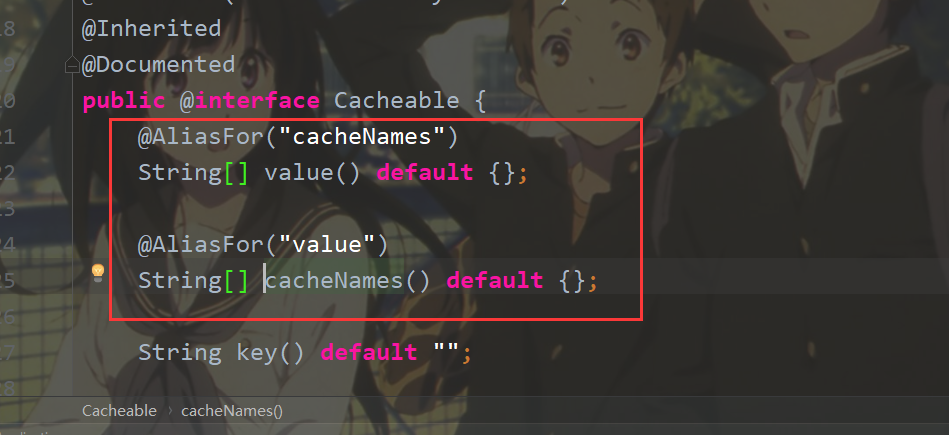
是数组的属性,所以是花括号的形式:cacheNames = {“empl”} 或 value={“empl”}
2)key:缓存数据使用的key。
默认是使用方法参数的值,比如这里id的值为1的话,key就等于1
多个参数的话,key默认就是 SimpleKey [参数值1,参数值2]
SimpleKey [1,jack]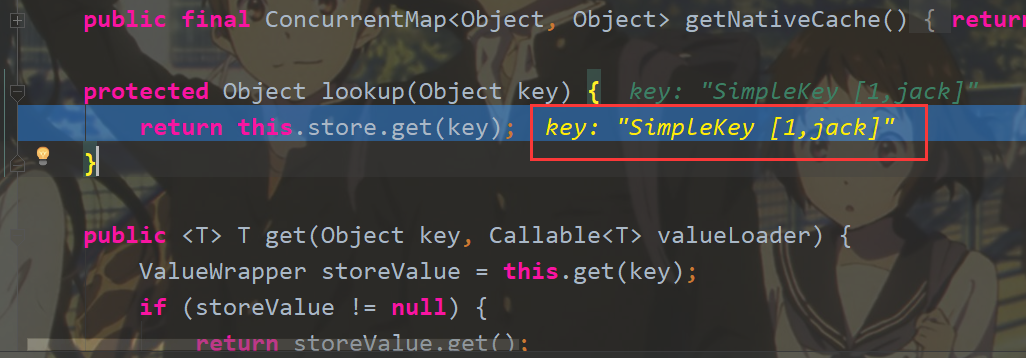
还可以使用SpEl表达式:
#id获取的参数的值。id就是参数的名字:key=1.
#a0、#p0 都是获取第一个参数的值,#a1 就是获取第二参数的值
#root.args[0]:也是获取第一个参数的值
举例:如果想要生成 方法名+参数值 的 key。比如这里的 findEmployeeById[1]
key = “#root.methodName+’[‘+#id+’]’”

3)keyGenerator: key的生成器,可以自己指定key的生成器的组件的id
key 或 keyGenerator:二选一
现在在config下,创建CacheConfig类: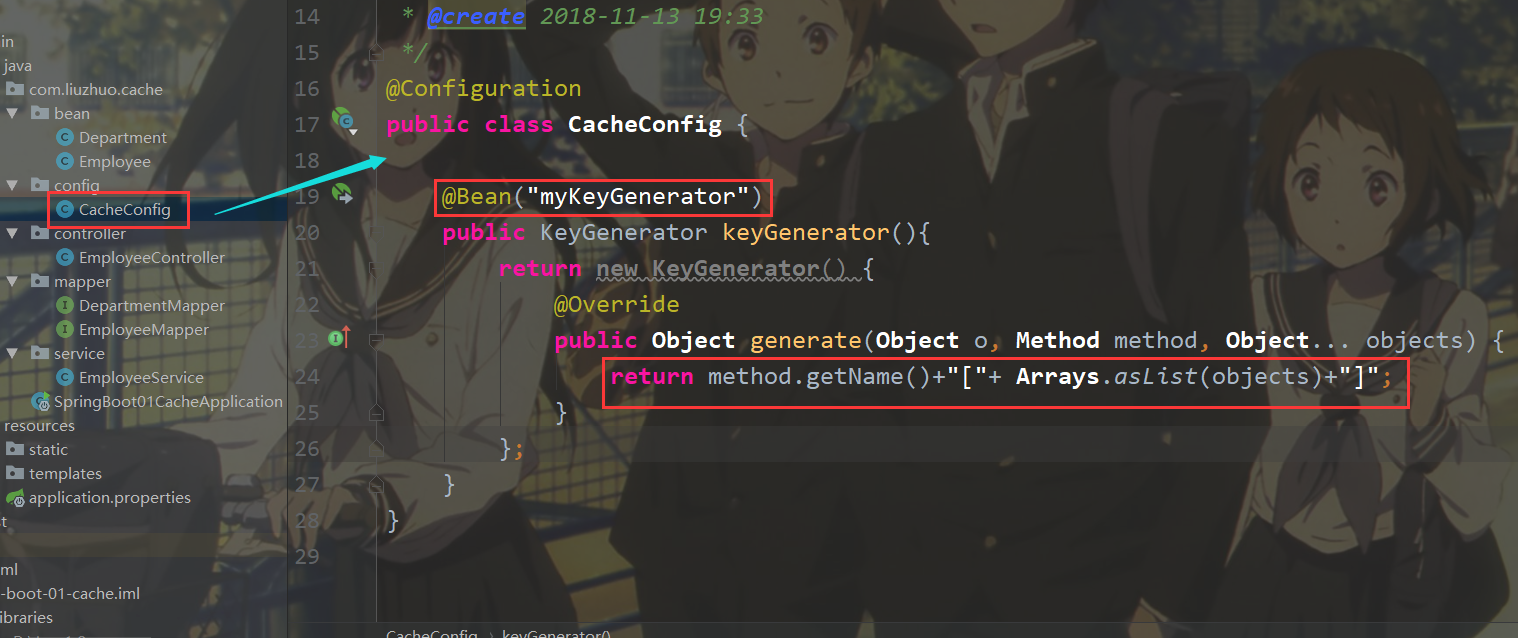
@Configuration
public class CacheConfig {
@Bean("myKeyGenerator")
public KeyGenerator keyGenerator(){
return new KeyGenerator() {
@Override
public Object generate(Object o, Method method, Object... objects) {
return method.getName()+"["+ Arrays.asList(objects)+"]";
}
};
}
}
注意这里的 KeyGenerator:org.springframework.cache.interceptor.KeyGenerator
然后,在 keyGenerator = “myKeyGenerator” :填写key的生成器的bean的id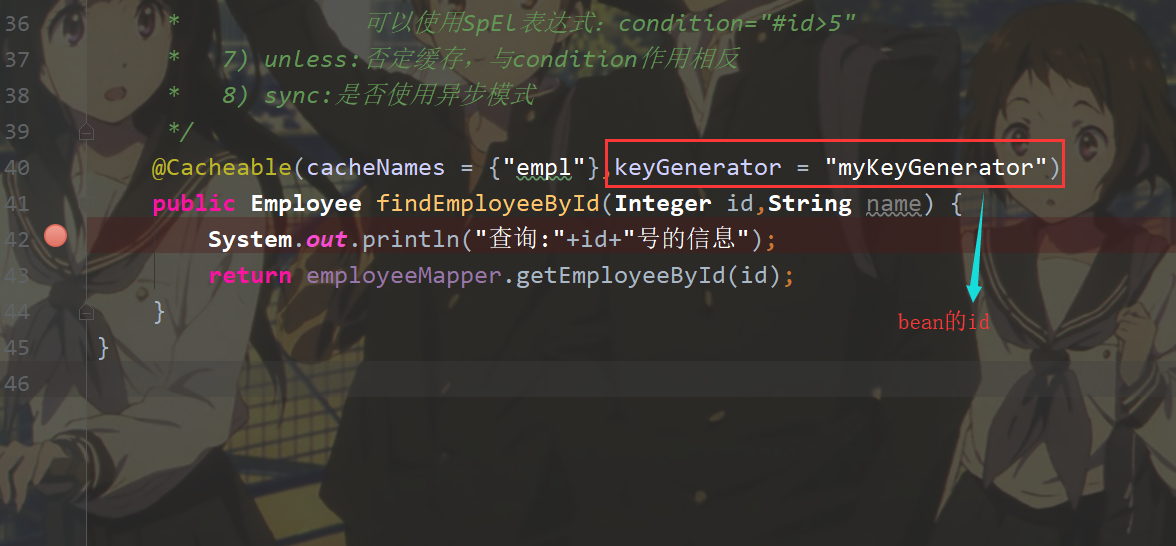
debug下: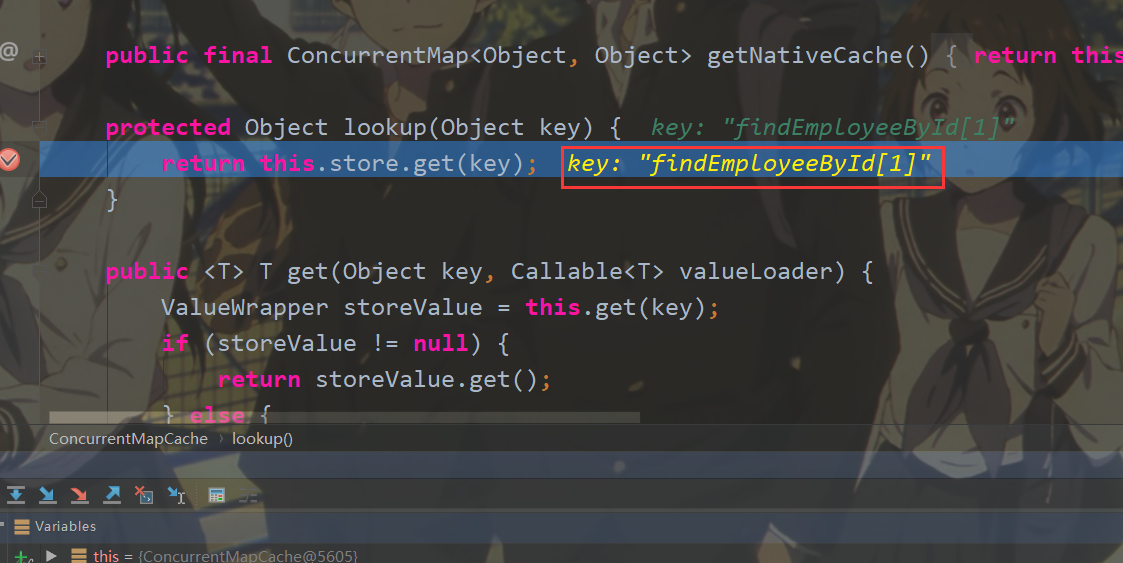
4) cacheManager:指定缓存管理器
以后整合其他缓存框架时,使用。
5) cacheResolver:指定缓存解析器。和cacheManager二选一
6) condition:指定符合条件的情况下,才缓存数据.
可以使用SpEl表达式:condition=”#id>5”. 当参数值大于5时,才会缓存数据。
7) unless:否定缓存,与condition作用相反
unless = “#id<2” 的话,就是参数值小于2时,不缓存
8) sync:是否使用异步模式
不过,当使用sync的话,unless是不能使用的。
@CachePut的使用
@CachePut:是用来更新缓存的,始终是先执行方法,然后更新缓存。
1)在 EmployeeService 添加 更新employee的方法: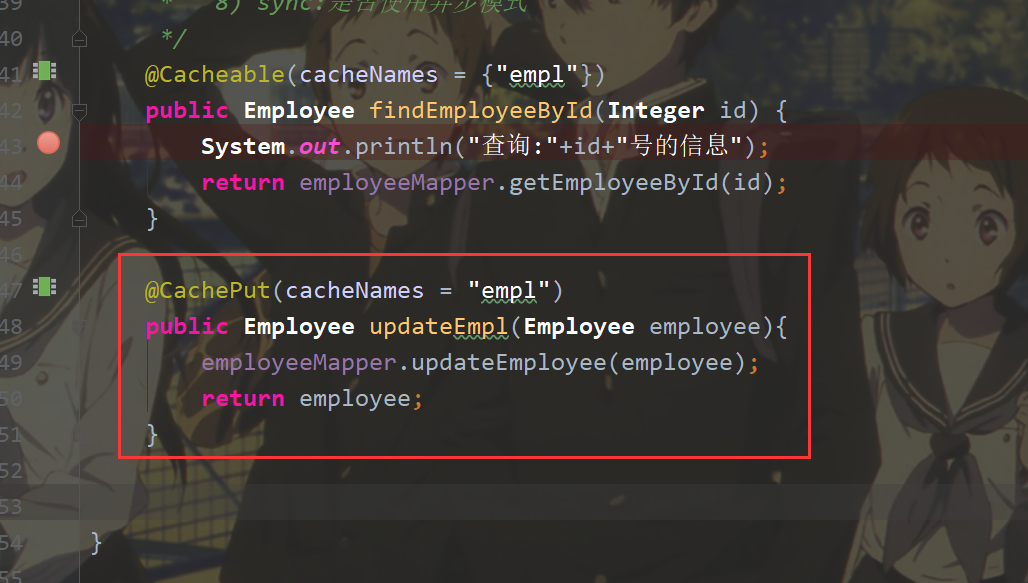
2)在 EmployeeController 添加 更新employee的映射方法: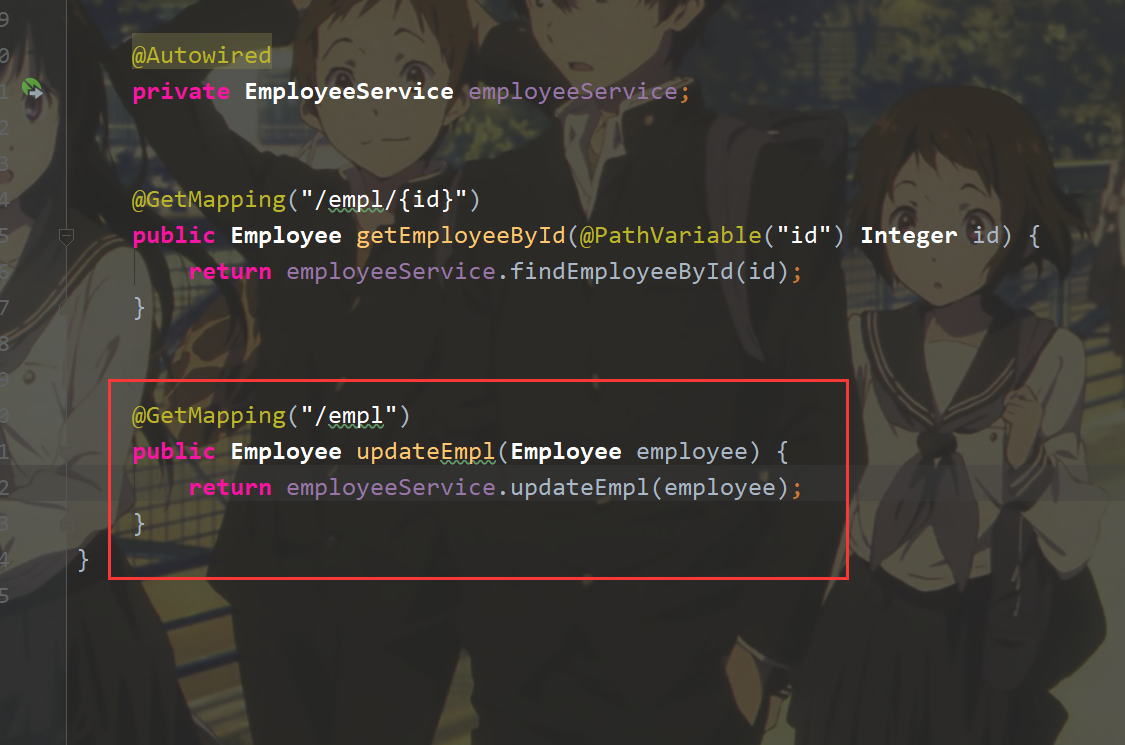
3)启动程序。
首先:输入:http://localhost:8080/empl/1 : 查询1号员工的信息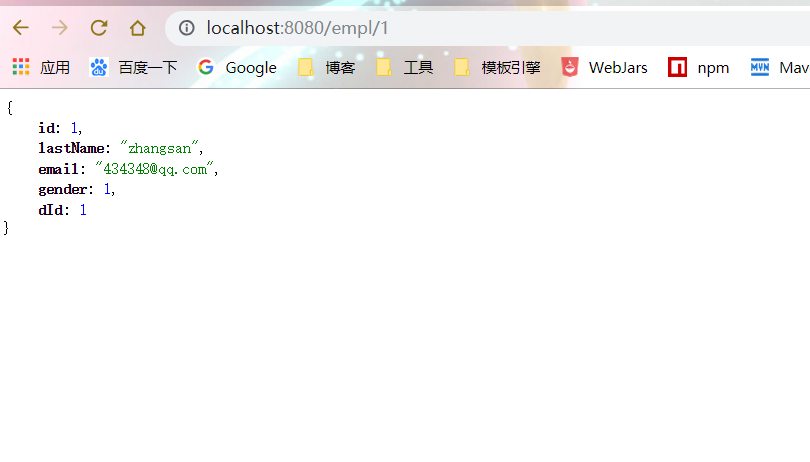

再次,访问1号员工的信息:
控制台,什么也不打印,但是界面有数据,说明,我们缓存数据成功!
现在,我们修改1号员工的信息:输入:http://localhost:8080/empl?id=1&lastName=zhangsan&gender=0
我们就修改了性别,从1变成0.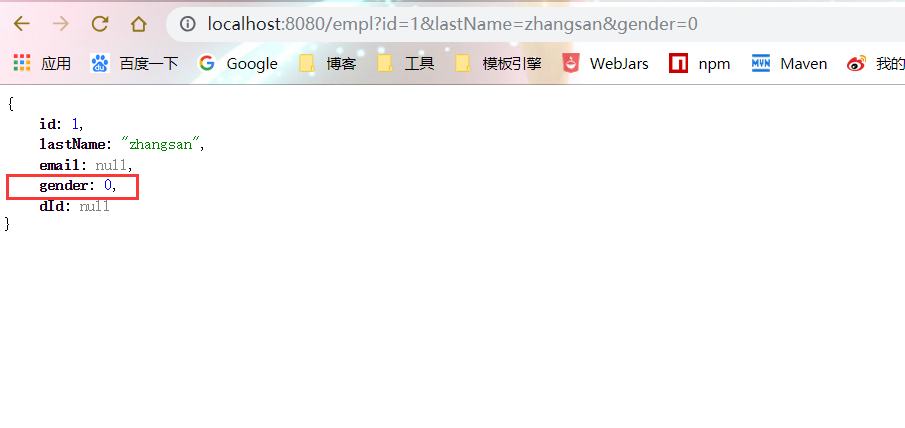

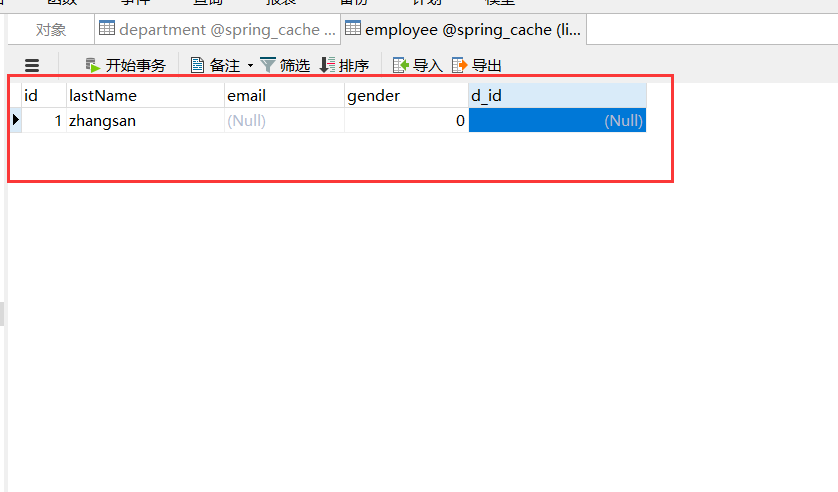
更新成功!!!
现在,我们再次,访问1号员工的信息,是从缓存中取?还是从数据库中取呢?如果从缓存中取,是旧的数据,还是新的数据?
反正,我们的最终目的是现在获取更新后的1号员工的信息。
我们来,测试一下,访问1号员工的信息:http://localhost:8080/empl/1
发现,控制台没有打印输出语句,说明现在还是从缓存中取数据。但是好像返回的数据是旧的?
这是为啥呢? 因为,虽然我们的获取缓存的名字 和 更新缓存的缓存的名字 都是empl。但是key不同呀!!!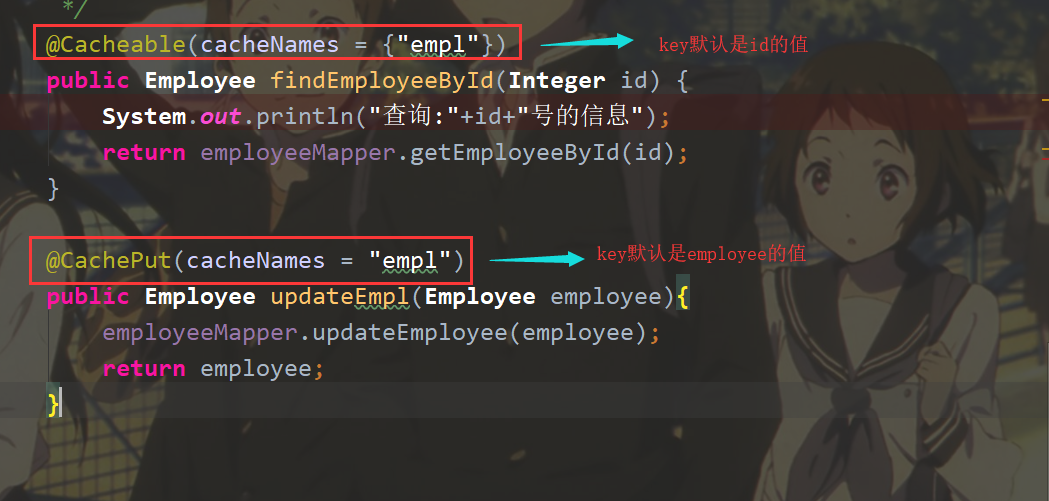
所以,现在名字为’empl’的cache中,有两个缓存,一个是key=1的缓存,另一个key=employee值的缓存。所以现在获取的是key=1的缓存(旧的数据)
要想达到我们想要的效果,必须key一致!!!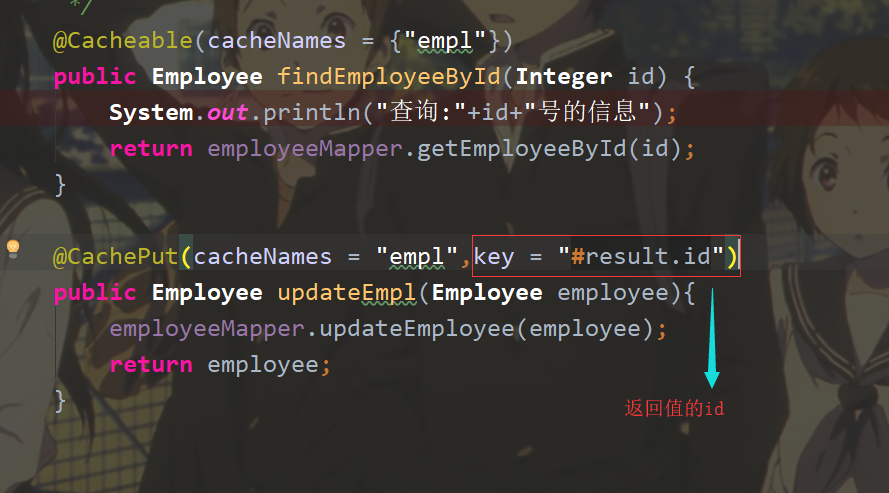
注意:@Cacheable的key,不能使用#result,因为@Cacheable是先执行缓存,再执行方法,而@CachePut总是先执行方法,再执行缓存。
重启应用,再次测试一次:
先访问1号员工:http://localhost:8080/empl/1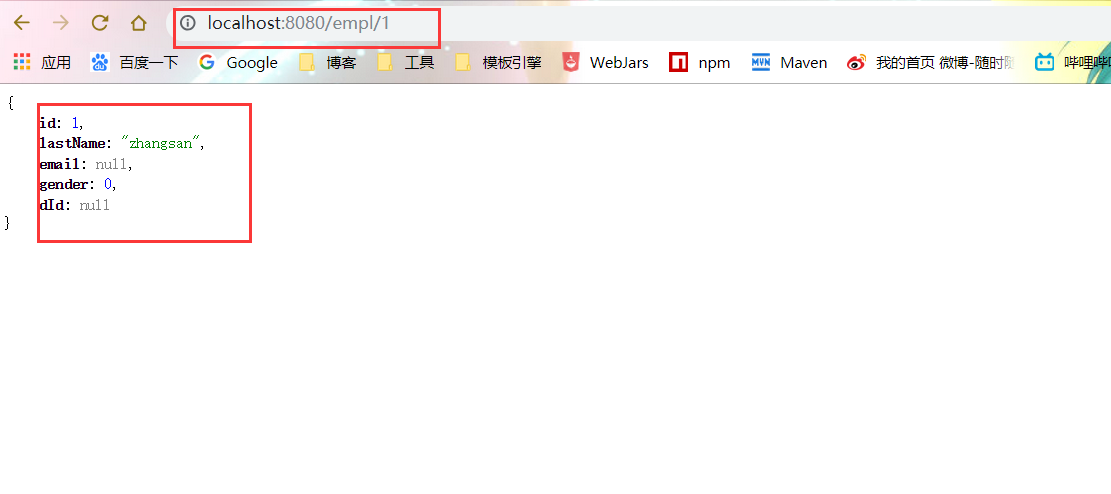
再修改1号员工:http://localhost:8080/empl?id=1&lastName=张三&gender=0&email=zhangsan@qq.com
再次访问1号员工:http://localhost:8080/empl/1
到达,我们的效果!!!
注意:这里我们的缓存的name是一致的,都是’empl’才行,如果你更改了name,不一致的话,效果就达不到了,原因, 你懂的
PS:如果张三在数据库中看是乱码的话,需要在数据库连接中添加 &characterEncoding=utf-8:
spring.datasource.url=jdbc:mysql://localhost:3306/spring_cache?useSSL=false&characterEncoding=utf-8
@CacheEvict的使用
@CacheEvict:是用来删除缓存的。
通过key:来删除指定的缓存。
allEntries = true. 删除所有的缓存,默认是为false。
当allEntries = true,就不用指定key了。
beforeInvocation = true。先清空缓存,再执行方法。默认是为false。
作用:默认情况下,当方法出现异常,缓存就不会清除。当beforeInvocation = true时,不管方法是否出现异常,都会清除缓存。
@Caching的使用
@Caching:组合注解: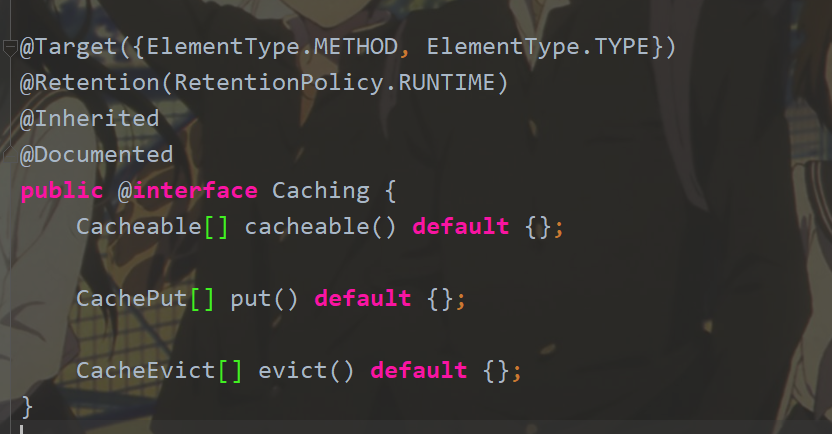

@CacheConfig的使用
@CacheConfig:是作用在类上面的,相当于全局配置。
此时,就不需要在每个方法上的缓存注解中,写cacheNames=’empl’. 如果写了,就使用方法上面的cacheNames。
整合Redis缓存
搭建redis环境
1)使用我们安装的虚拟机工具安装Redis
如果不清楚的话,看之前的SpringBoot基础篇,docker学习
打开虚拟机: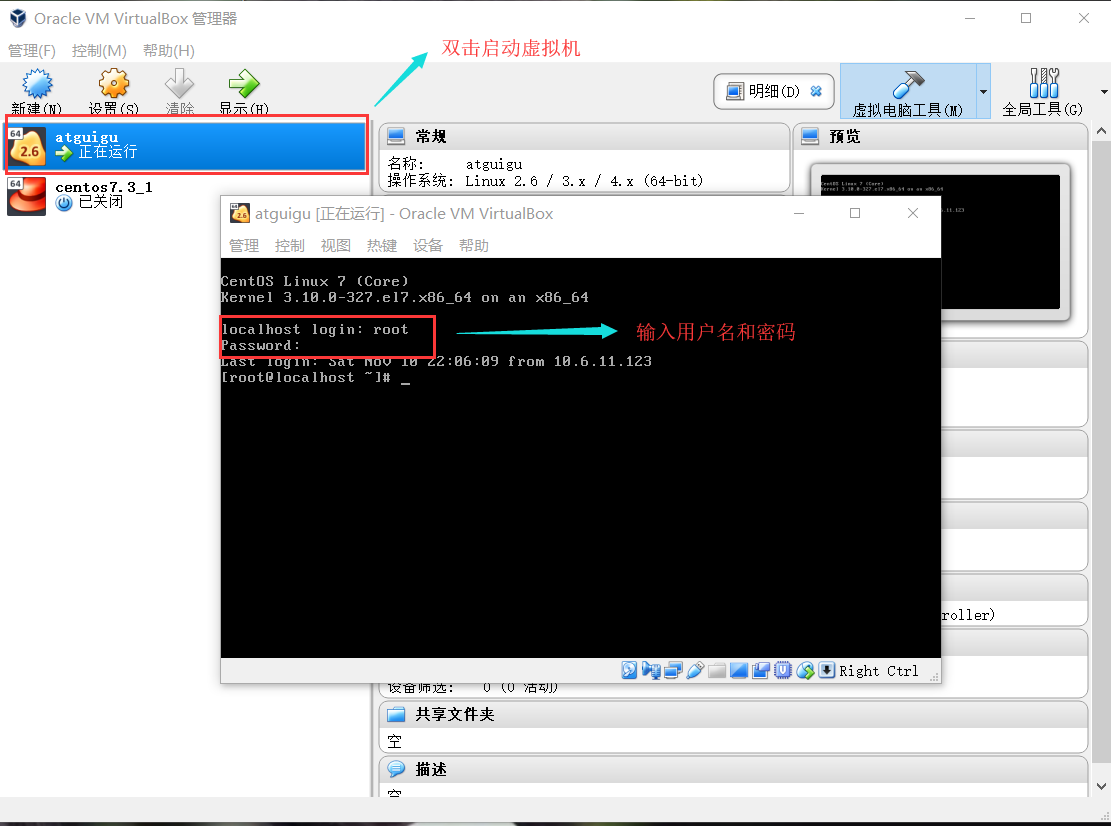
打开连接虚拟机的客户端:SmarTTY

在docker hub中搜索Redis的镜像
docker官方的镜像在国外,下载镜像会很慢,所以使用国内的docker镜像:https://www.docker-cn.com/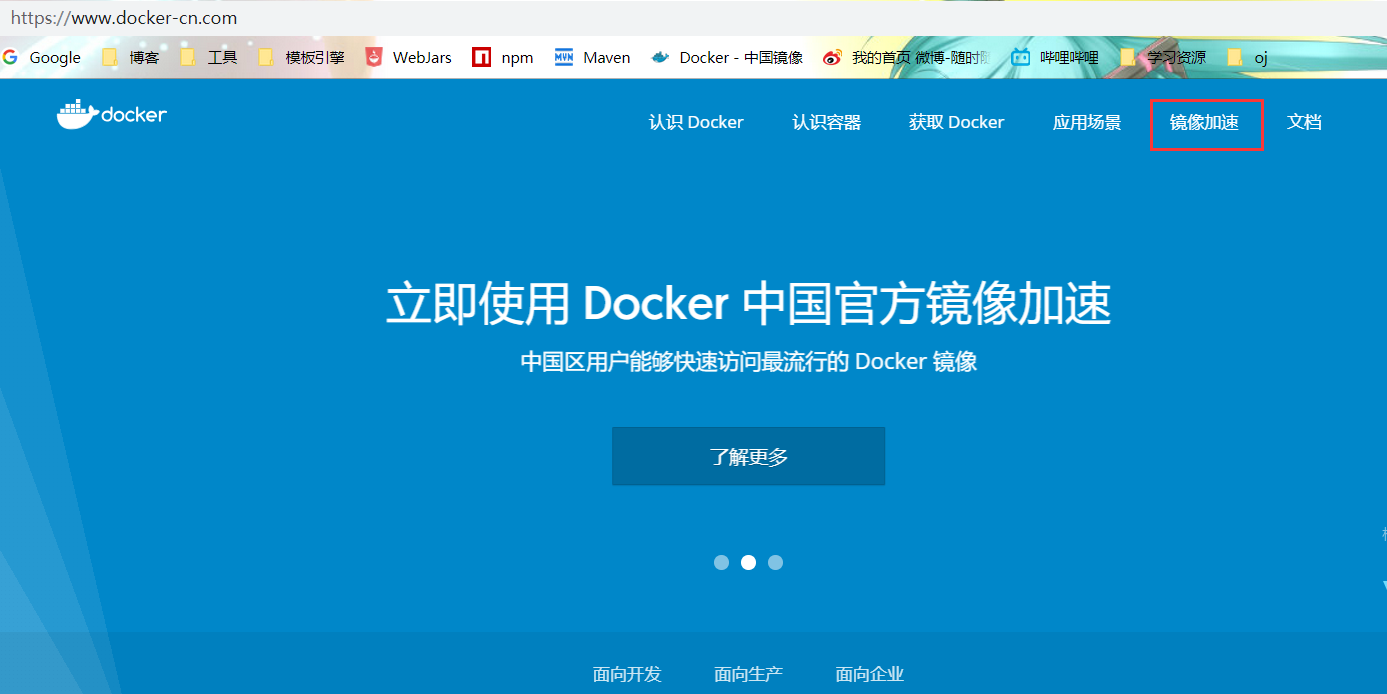

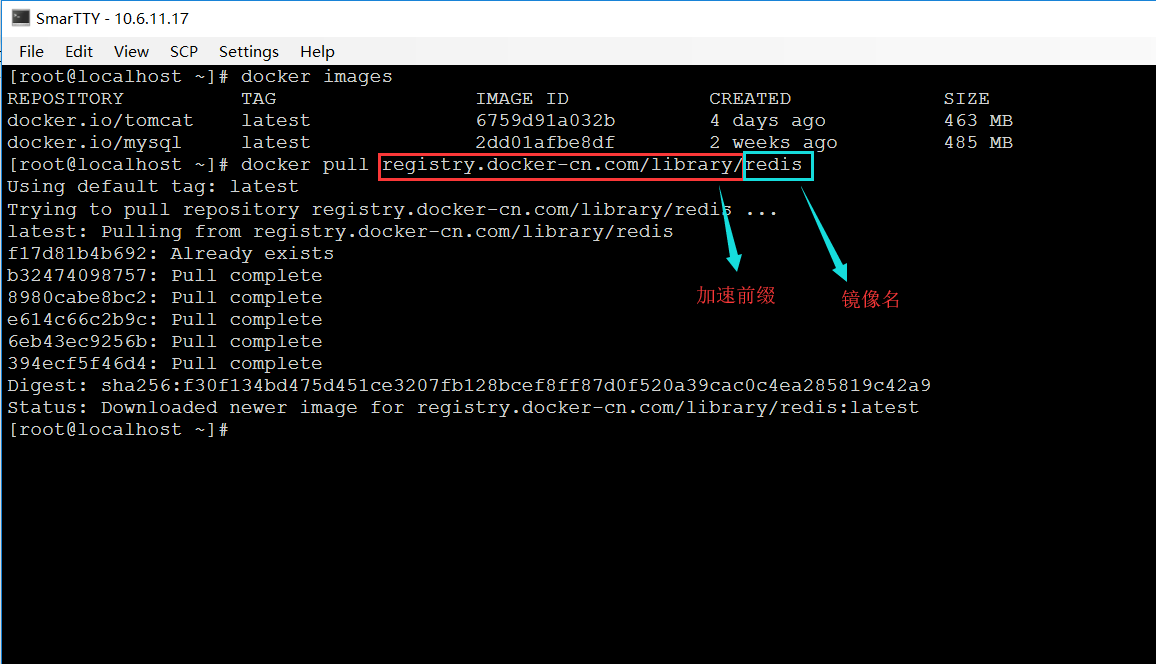
运行我们下载的redis镜像:
docker run -d -p 6379:6379 --name myredis registry.docker-cn.com/library/redis
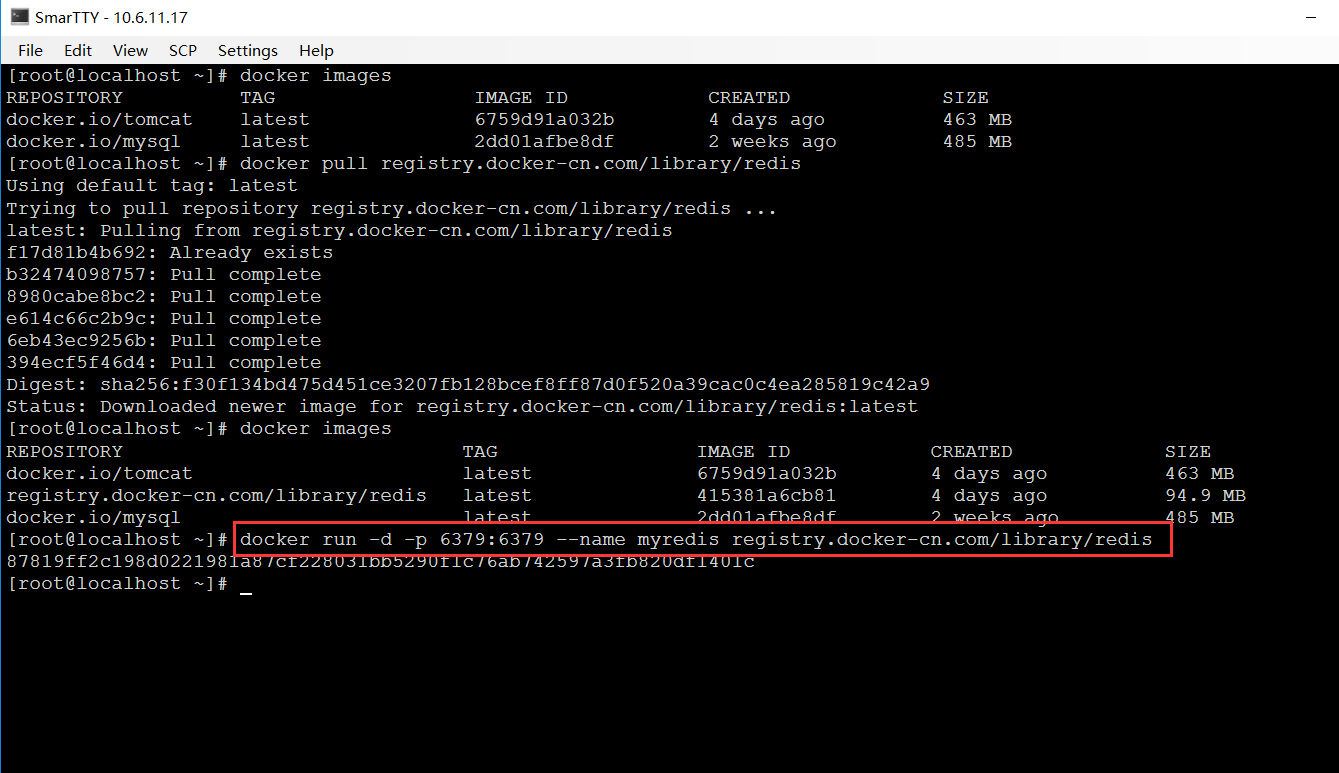
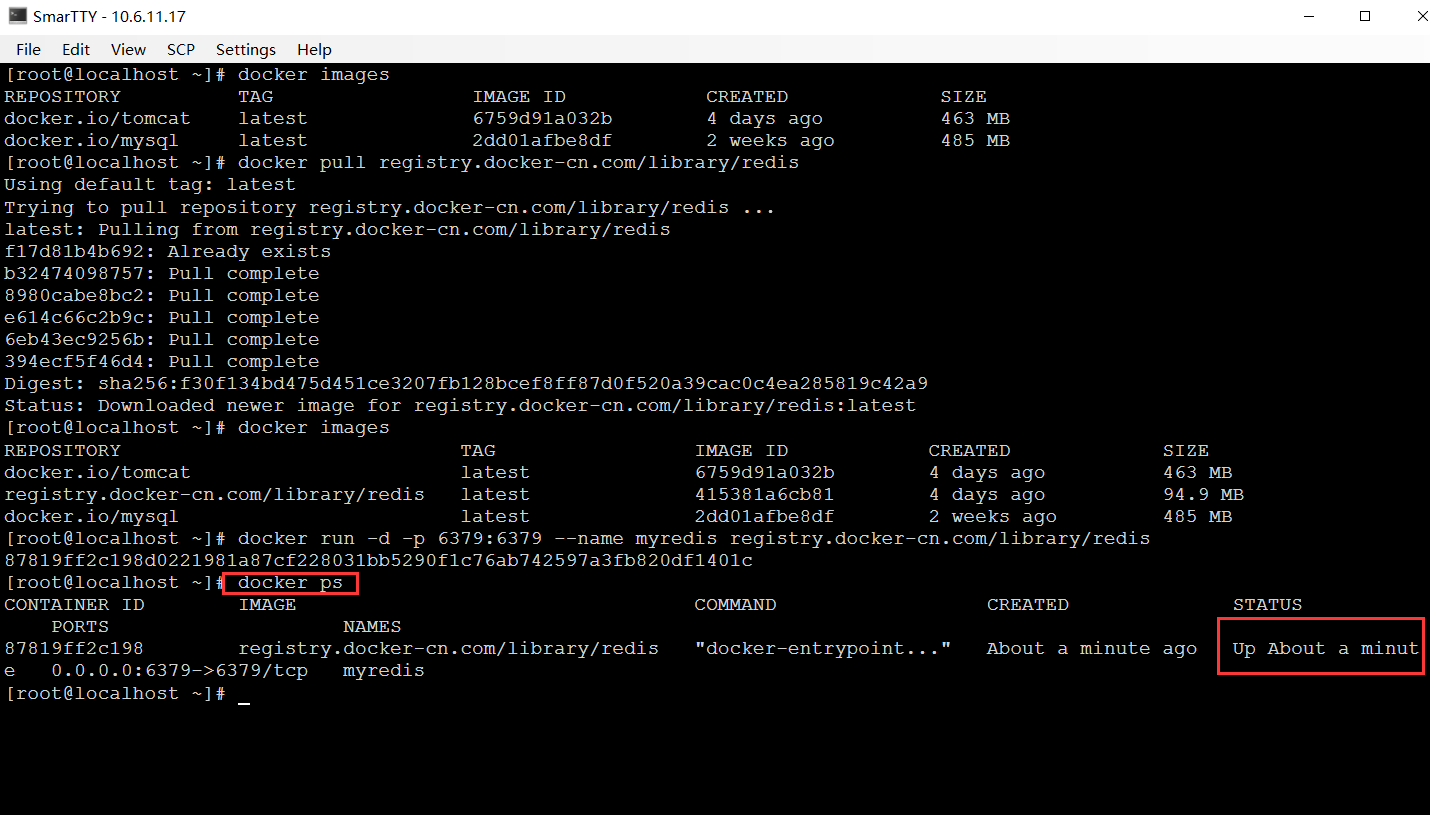
2) 打开redis的客户端:RedisDesktopManager(自行下载)
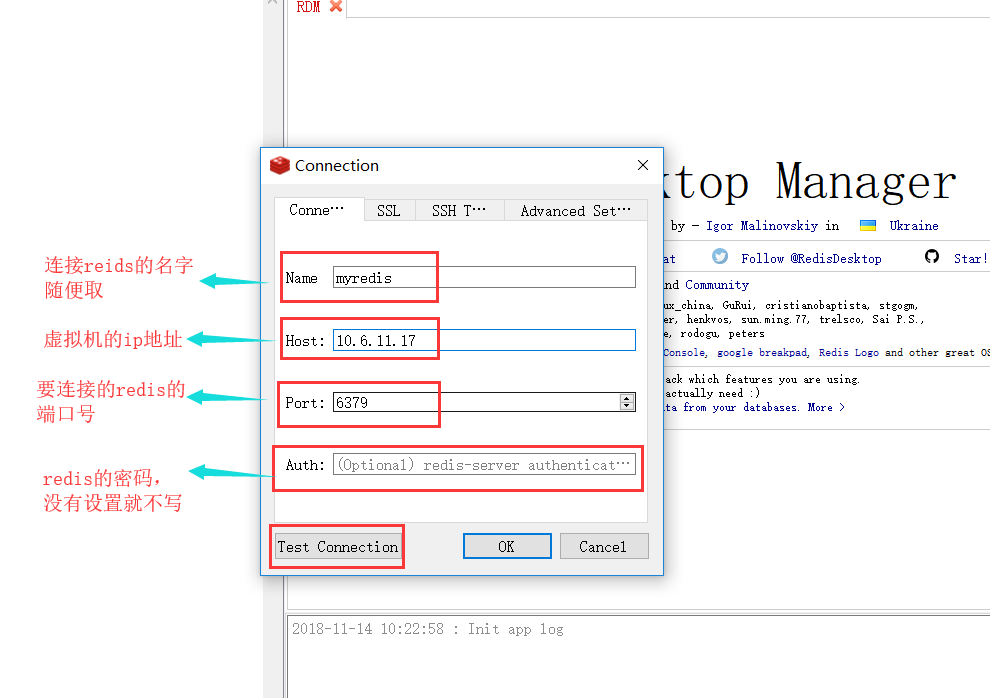
默认redis:16个数据库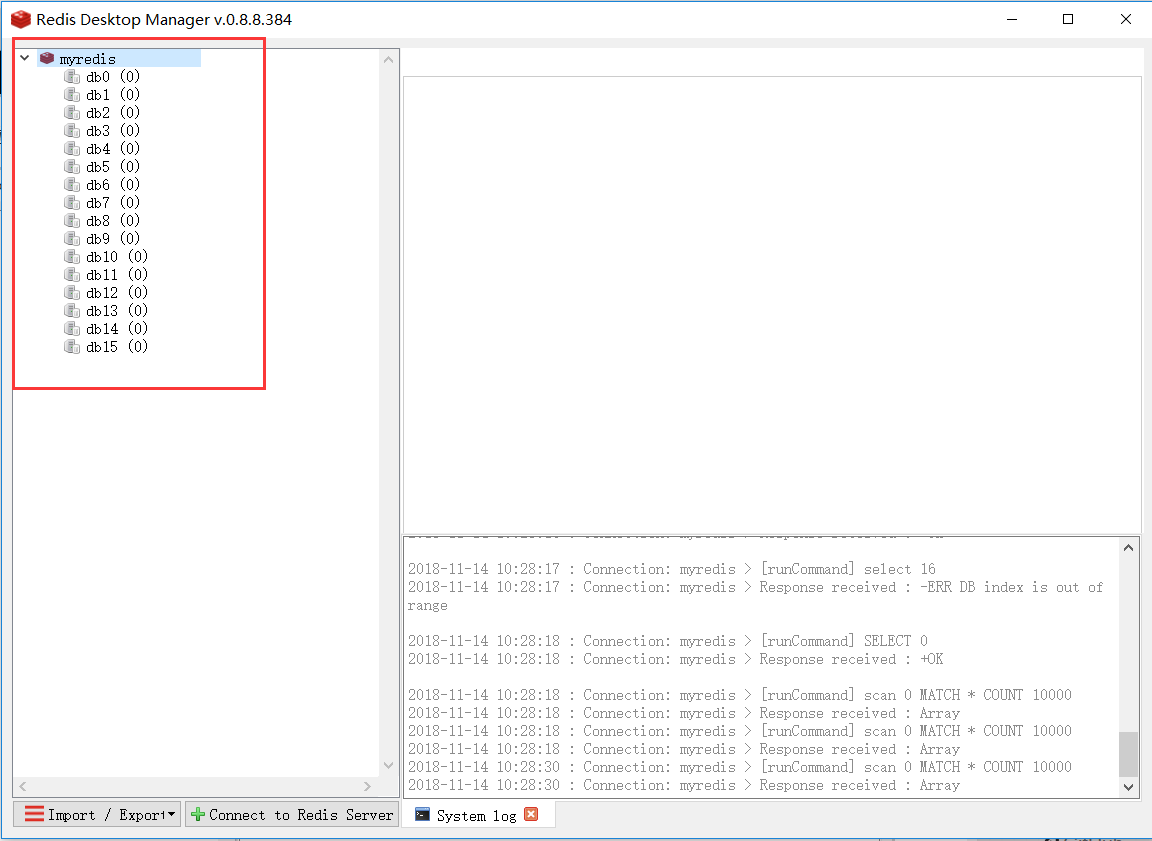
3)简单试试redis的命令
在myredis上面,右键选择:Console
打开redis中文网:http://www.redis.cn/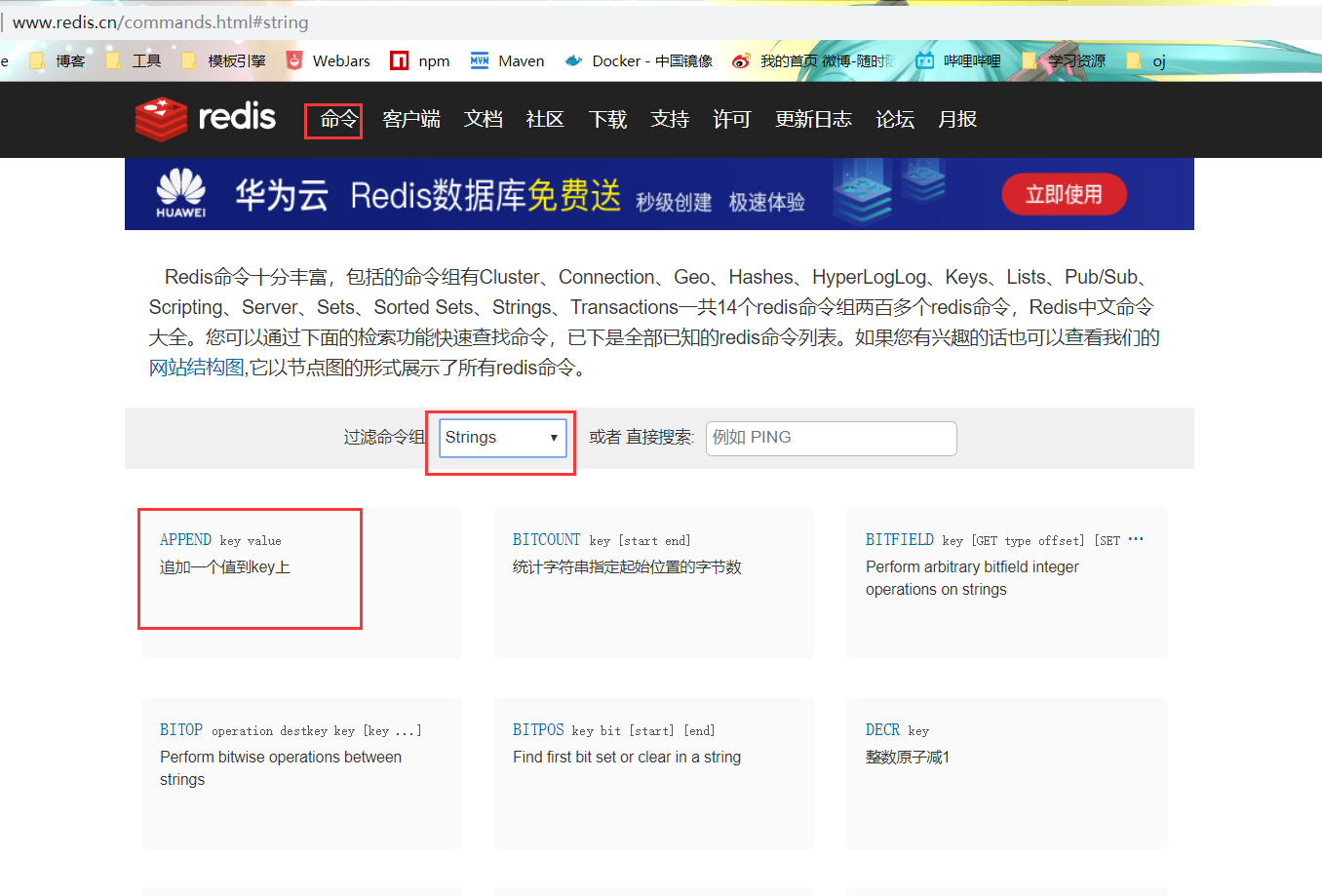
以String类型为例:
其他命令,请读者自行学习啦~
整合redis
SpringBoot,默认的配置类是:SimpleCacheConfiguration
默认使用的CacheManager:ConcurrentMapCacheManager
默认使用的Cache:ConcurrentMapCache
现在,整合redis到SpringBoot中。
1)导入redis的stars依赖
<dependency>
<groupId>org.springframework.boot</groupId>
<artifactId>spring-boot-starter-data-redis</artifactId>
</dependency>
2) 在Application配置文件中,添加redis的连接
#设置redis的连接
spring.redis.host=10.6.11.17
这里的 host: 写你自己的虚拟机的ip地址。
3)打开RedisAutoConfiguration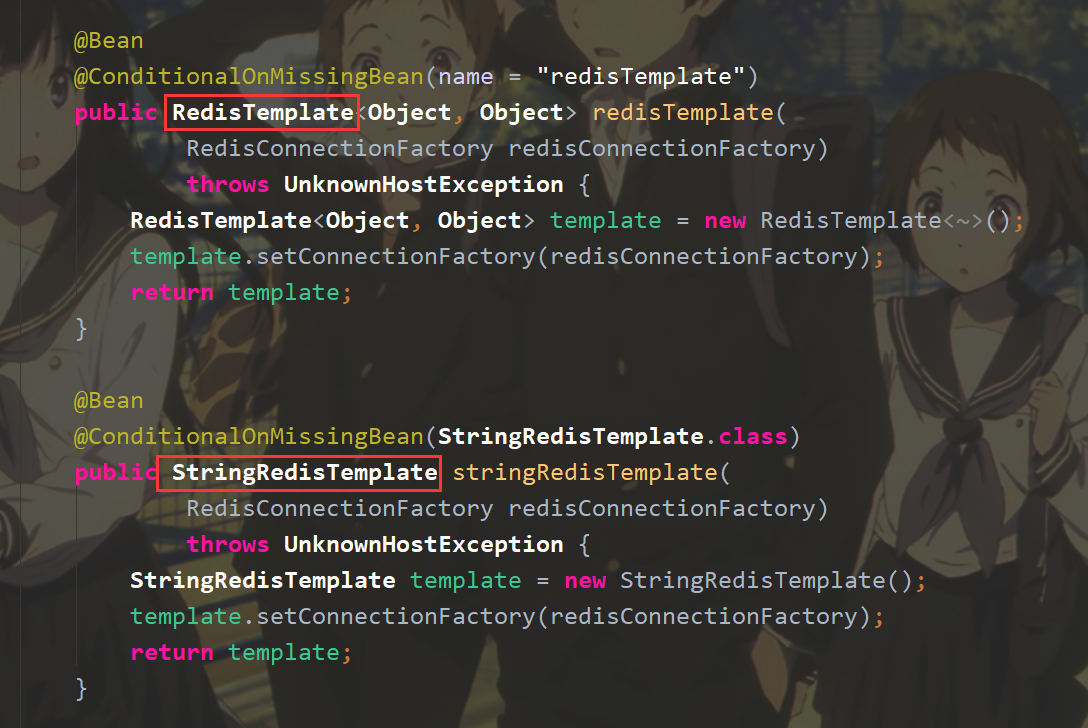
发现:导入了两个模板类,方便我们操作。
4)在SpringBoot01CacheApplicationTests类中:
@RunWith(SpringRunner.class)
@SpringBootTest
public class SpringBoot01CacheApplicationTests {
@Autowired
private EmployeeMapper employeeMapper;
@Autowired
private RedisTemplate redisTemplate; //操作k-v,都是对象的
@Autowired
private StringRedisTemplate stringRedisTemplate; //操作k-v:k是字符串的
/**
* redis:5种数据结构:
* 字符串String,list(列表),hash(哈希),set(集合),ZSet(有序集合)
* opsForValue():String
* opsForList():list
* opsForHash():hash
* opsForSet():set
* opsForZSet():ZSet
*/
@Test
public void test01(){
stringRedisTemplate.opsForValue().append("mgs","hello");
}
@Test
public void contextLoads() {
}
}
清空:redis中的数据。执行test01

其他命令,自行执行测试。
现在测试RedisTemplate:
@Test
public void test02() {
Employee employee = employeeMapper.getEmployeeById(1);
//将对象放入到redis中
redisTemplate.opsForValue().set("empl", employee);
}
运行测试方法:
出现无法序列化异常,因为对象保存到redis中,是以序列化的形式。而我们的Employee没有实现序列化。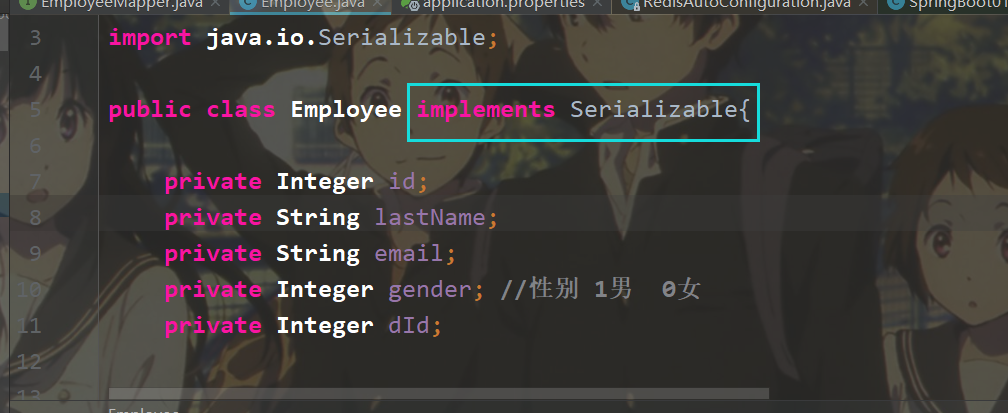
再次运行: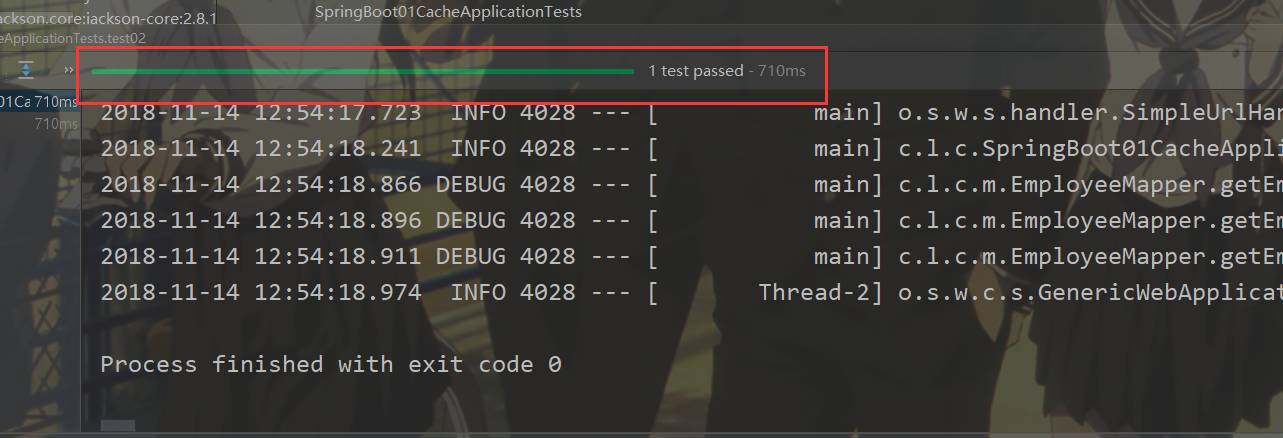

虽然成功了,但是是序列化的形式,看着不爽。
默认是jdk的序列化形式:
我们可以自定义自己的序列化方式:
使用我们自己的redis模板,设置自己的json的序列化形式:
在config包下: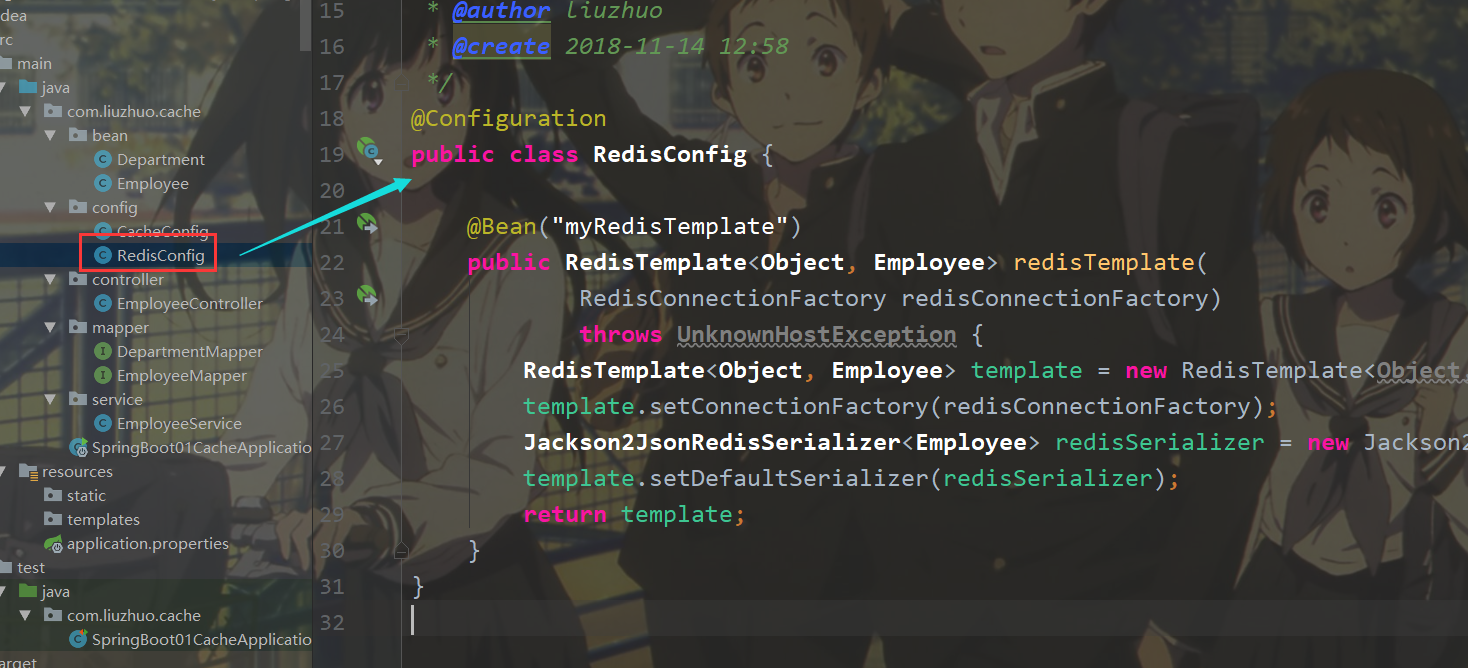
@Configuration
public class RedisConfig {
@Bean("myRedisTemplate")
public RedisTemplate<Object, Employee> redisTemplate(
RedisConnectionFactory redisConnectionFactory)
throws UnknownHostException {
RedisTemplate<Object, Employee> template = new RedisTemplate<Object, Employee>();
template.setConnectionFactory(redisConnectionFactory);
//使用json的序列化
Jackson2JsonRedisSerializer<Employee> redisSerializer = new Jackson2JsonRedisSerializer<Employee>(Employee.class);
template.setDefaultSerializer(redisSerializer);
return template;
}
}
使用自己的redis模板: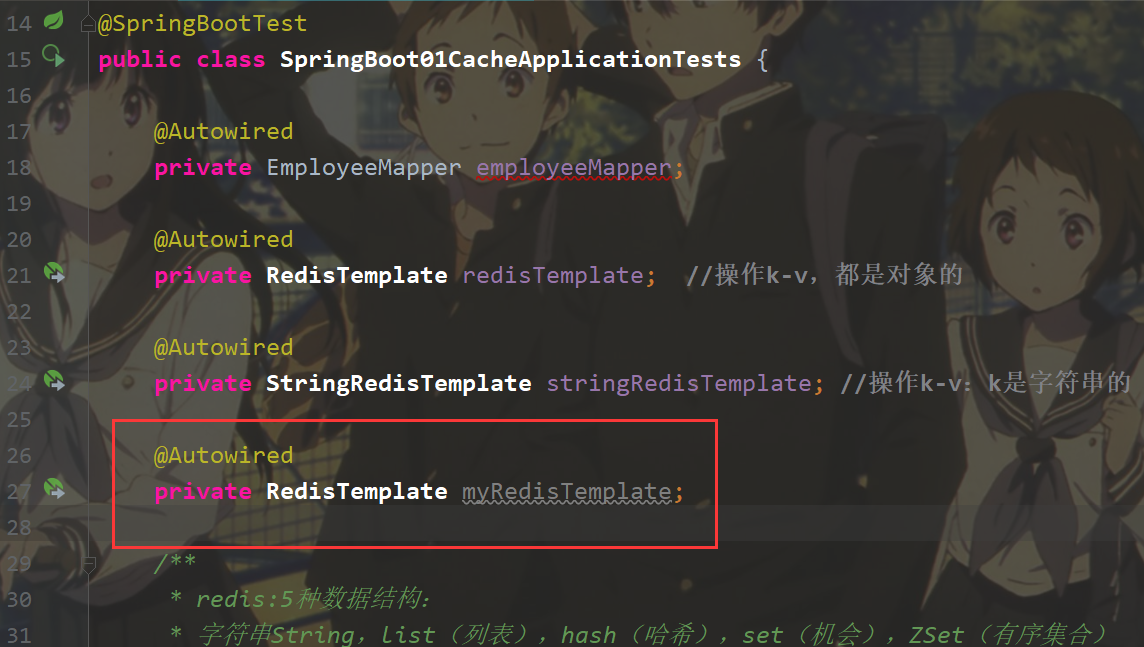
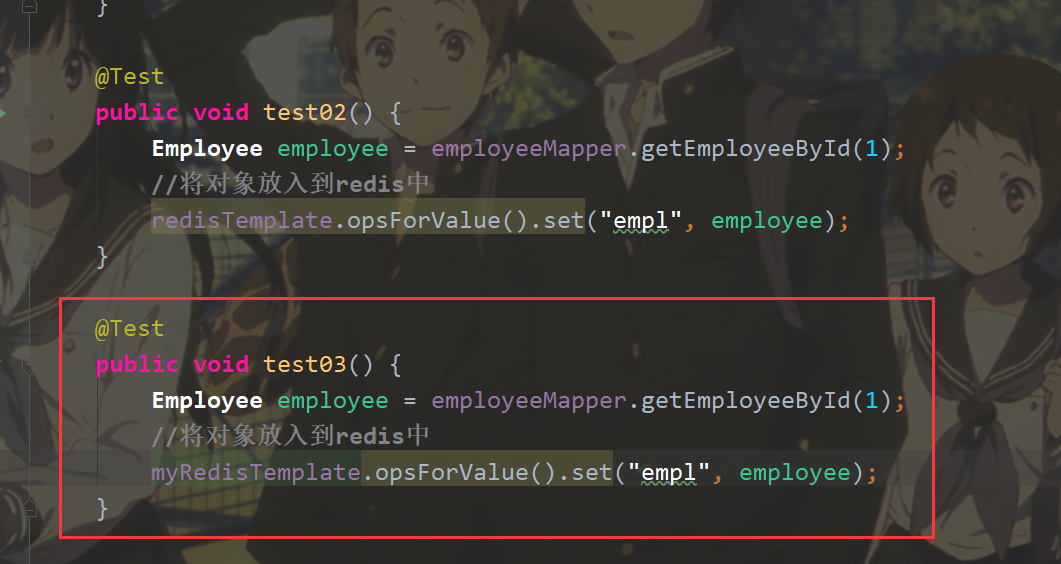
运行test03方法: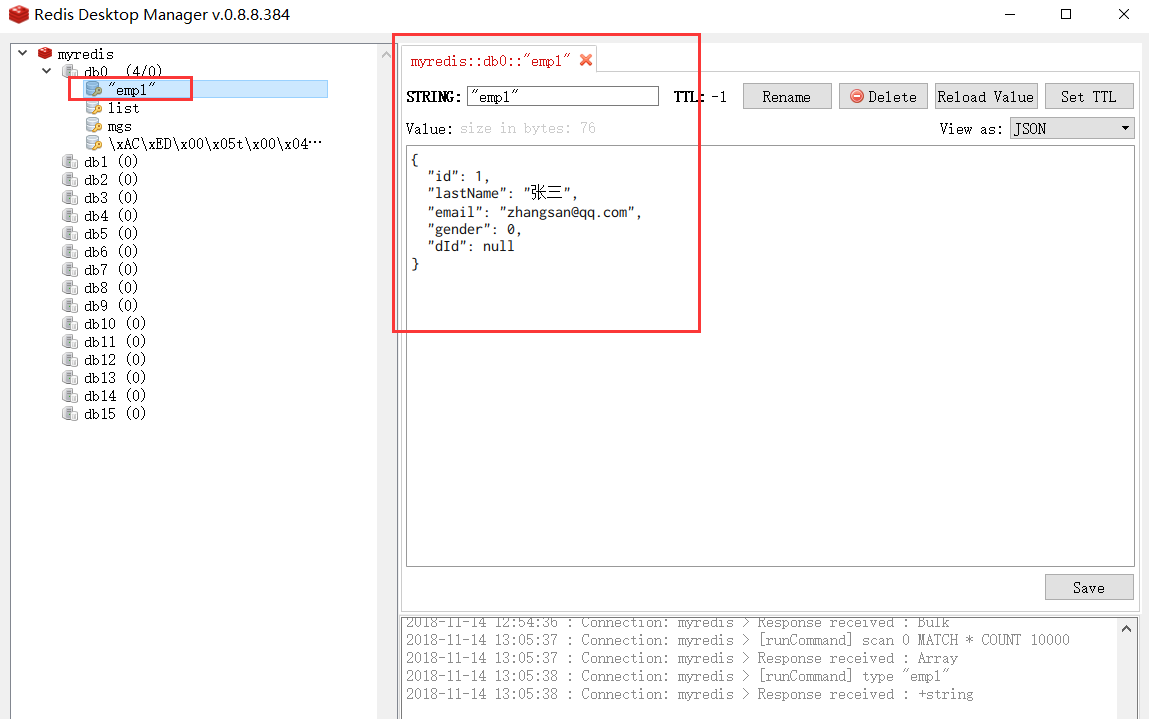
以上我们的redis已经整合成功了。
使用redis缓存
我们知道,SpringBoot默认使用:SimpleCacheConfiguration
导入redis-starter后,就会使用 RedisAutoConfiguration。
然后默认使用:RedisTemplate模板。
现在直接启动SpringBoot应用:
在浏览器中输入:http://localhost:8080/empl/1


再次输入:http://localhost:8080/empl/1
会从缓存中获取数据,控制台不会打印sql语句。

不是我们想要的序列化形式:
我们需要自己配置RedisCacheManager:
打开:RedisCacheConfiguration类:
发现默认的RedisCacheManager:
现在在我们的RedisConfig类: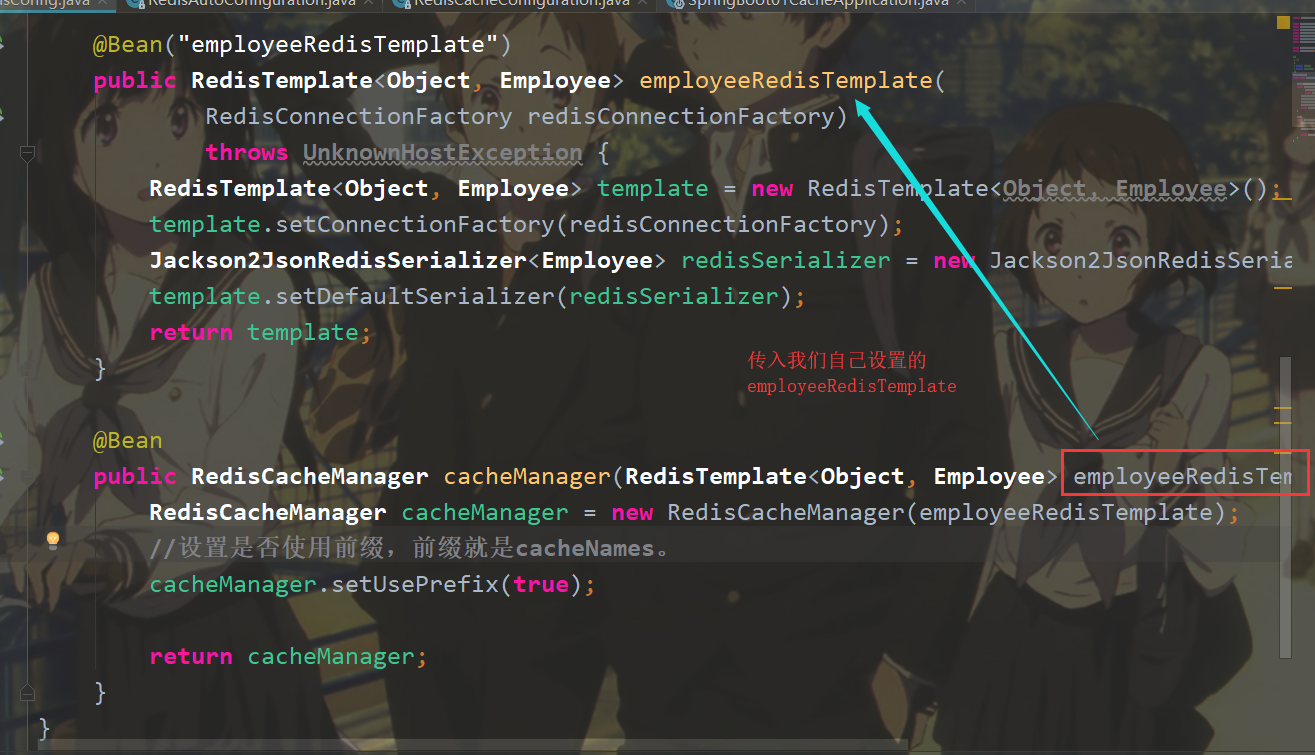
@Configuration
public class RedisConfig {
@Bean("employeeRedisTemplate")
public RedisTemplate<Object, Employee> employeeRedisTemplate(
RedisConnectionFactory redisConnectionFactory)
throws UnknownHostException {
RedisTemplate<Object, Employee> template = new RedisTemplate<Object, Employee>();
template.setConnectionFactory(redisConnectionFactory);
Jackson2JsonRedisSerializer<Employee> redisSerializer = new Jackson2JsonRedisSerializer<Employee>(Employee.class);
template.setDefaultSerializer(redisSerializer);
return template;
}
@Bean
public RedisCacheManager cacheManager(RedisTemplate<Object, Employee> employeeRedisTemplate) {
RedisCacheManager cacheManager = new RedisCacheManager(employeeRedisTemplate);
//设置是否使用前缀,前缀就是cacheNames。
cacheManager.setUsePrefix(true);
return cacheManager;
}
}
我们配置了自己的RedisCacheManager,默认的就会失效,因为: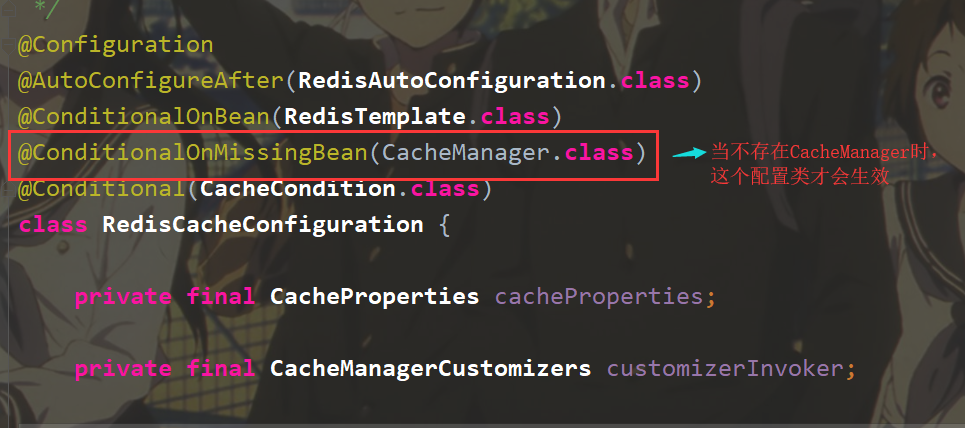
现在,我们使用department来测试:编写departmentMapper,departmentService,departmentController:
DepartmentMapper:
@Mapper
public interface DepartmentMapper {
@Select("select * from department where id=#{id}")
public Department getDeptById(Integer id);
}
DepartmentService:
@Service
public class DepartmentService {
@Autowired
private DepartmentMapper departmentMapper;
@Cacheable(cacheNames = "dept")
public Department getDeptById(Integer id){
return departmentMapper.getDeptById(id);
}
}
DepartmentController:
@RestController
public class DepartmentController {
@Autowired
private DepartmentService departmentService;
@GetMapping("/dept/{id}")
public Department getDeptById(@PathVariable("id") Integer id) {
return departmentService.getDeptById(id);
}
}
启动应用:
清空redis数据库。
在浏览器中输入:http://localhost:8080/empl/1
第一次查询,会从数据库中查询数据,然后放到缓存中。


此时redis数据库中,是以json啦来序列化的。
再次:访问http://localhost:8080/empl/1,控制台不会打印sql语句,说明是从缓存中取的。
现在,我们来测试department。在mysql客户端中,自己手动插入一条数据:
在浏览器中输入:http://localhost:8080/dept/1
第一次,会从数据库中获取数据。控制台打印sql语句。将数据放到redis缓存中。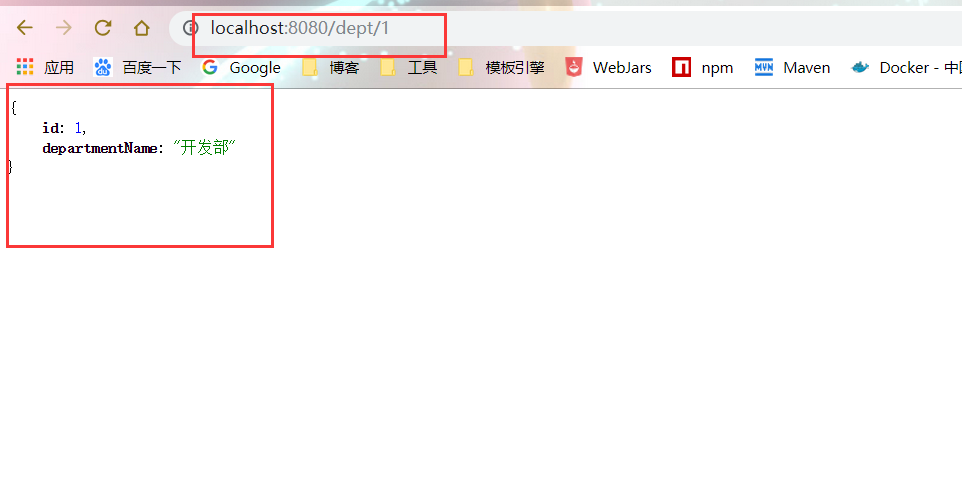

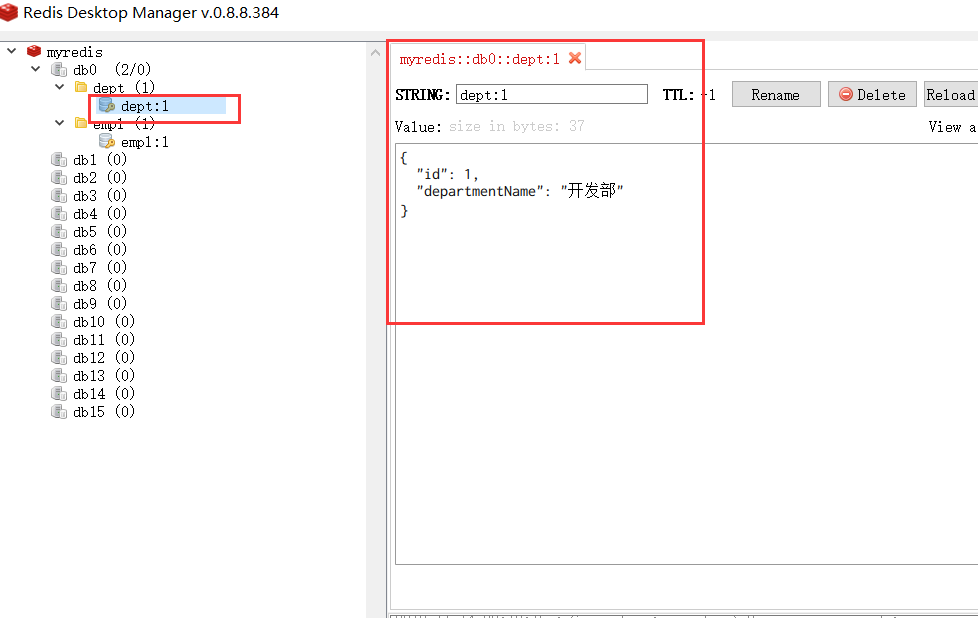
当再次访问:http://localhost:8080/dept/1,照理应该会把department的json数据反序列化到前端,不到mysql数据库中查找。
但是出错了!!!
看出错的异常,是我们居然是把department的json数据反序列化到employee对象上面,当然出错呀!
打开我们的cacheConfig类:
@Configuration
public class RedisConfig {
@Bean("employeeRedisTemplate")
public RedisTemplate<Object, Employee> employeeRedisTemplate(
RedisConnectionFactory redisConnectionFactory)
throws UnknownHostException {
RedisTemplate<Object, Employee> template = new RedisTemplate<Object, Employee>();
template.setConnectionFactory(redisConnectionFactory);
Jackson2JsonRedisSerializer<Employee> redisSerializer = new Jackson2JsonRedisSerializer<Employee>(Employee.class);
template.setDefaultSerializer(redisSerializer);
return template;
}
@Bean
public RedisCacheManager cacheManager(RedisTemplate<Object, Employee> employeeRedisTemplate) {
RedisCacheManager cacheManager = new RedisCacheManager(employeeRedisTemplate);
//设置是否使用前缀,前缀就是cacheNames。
cacheManager.setUsePrefix(true);
return cacheManager;
}
}
我们的序列化泛型就是Employee对象,所以只能对Employee反序列化成功。
现在添加新的 RedisCacheManager 和 RedisTemplate
@Configuration
public class RedisConfig {
@Bean("employeeRedisTemplate")
public RedisTemplate<Object, Employee> employeeRedisTemplate(
RedisConnectionFactory redisConnectionFactory)
throws UnknownHostException {
RedisTemplate<Object, Employee> template = new RedisTemplate<Object, Employee>();
template.setConnectionFactory(redisConnectionFactory);
Jackson2JsonRedisSerializer<Employee> redisSerializer = new Jackson2JsonRedisSerializer<Employee>(Employee.class);
template.setDefaultSerializer(redisSerializer);
return template;
}
@Bean("departmentRedisTemplate")
public RedisTemplate<Object, Department> departmentRedisTemplate(
RedisConnectionFactory redisConnectionFactory)
throws UnknownHostException {
RedisTemplate<Object, Department> template = new RedisTemplate<Object, Department>();
template.setConnectionFactory(redisConnectionFactory);
Jackson2JsonRedisSerializer<Department> redisSerializer = new Jackson2JsonRedisSerializer<Department>(Department.class);
template.setDefaultSerializer(redisSerializer);
return template;
}
@Bean("employeeCacheManager")
public RedisCacheManager employeeCacheManager(RedisTemplate<Object, Employee> employeeRedisTemplate) {
RedisCacheManager cacheManager = new RedisCacheManager(employeeRedisTemplate);
//设置是否使用前缀,前缀就是cacheNames。
cacheManager.setUsePrefix(true);
return cacheManager;
}
@Bean("departmentCacheManager")
public RedisCacheManager departmentCacheManager(RedisTemplate<Object, Department> departmentRedisTemplate) {
RedisCacheManager cacheManager = new RedisCacheManager(departmentRedisTemplate);
//设置是否使用前缀,前缀就是cacheNames。
cacheManager.setUsePrefix(true);
return cacheManager;
}
}
现在在EmployeeService中,设置CacheManager:
在类上面的,@CacheConfig中设置统一的CacheManager
在DepartmentService: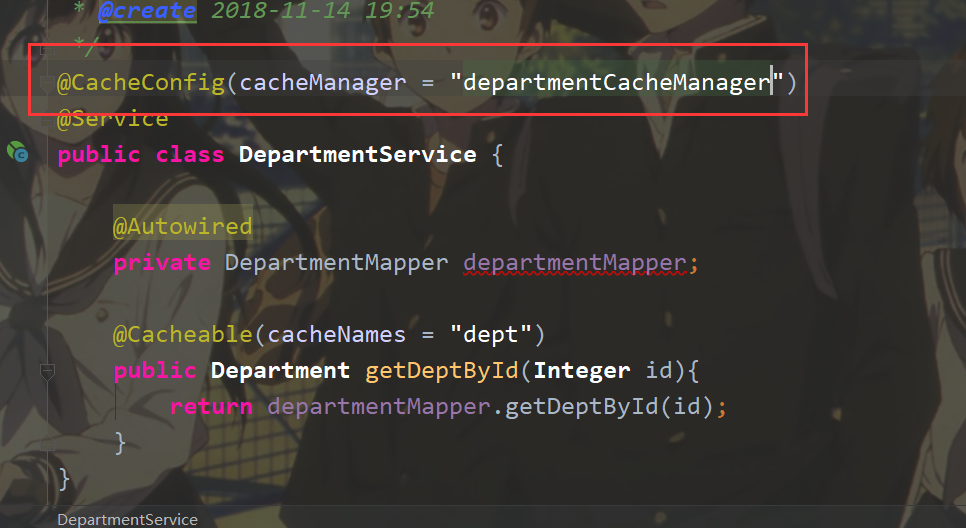
这样,Employee 和 Department 就会使用各自的CacheManager。
删除Redis中的所有数据。再次测试一下,启动应用。
启动应用的过程中,出错了!你敢信,我们看看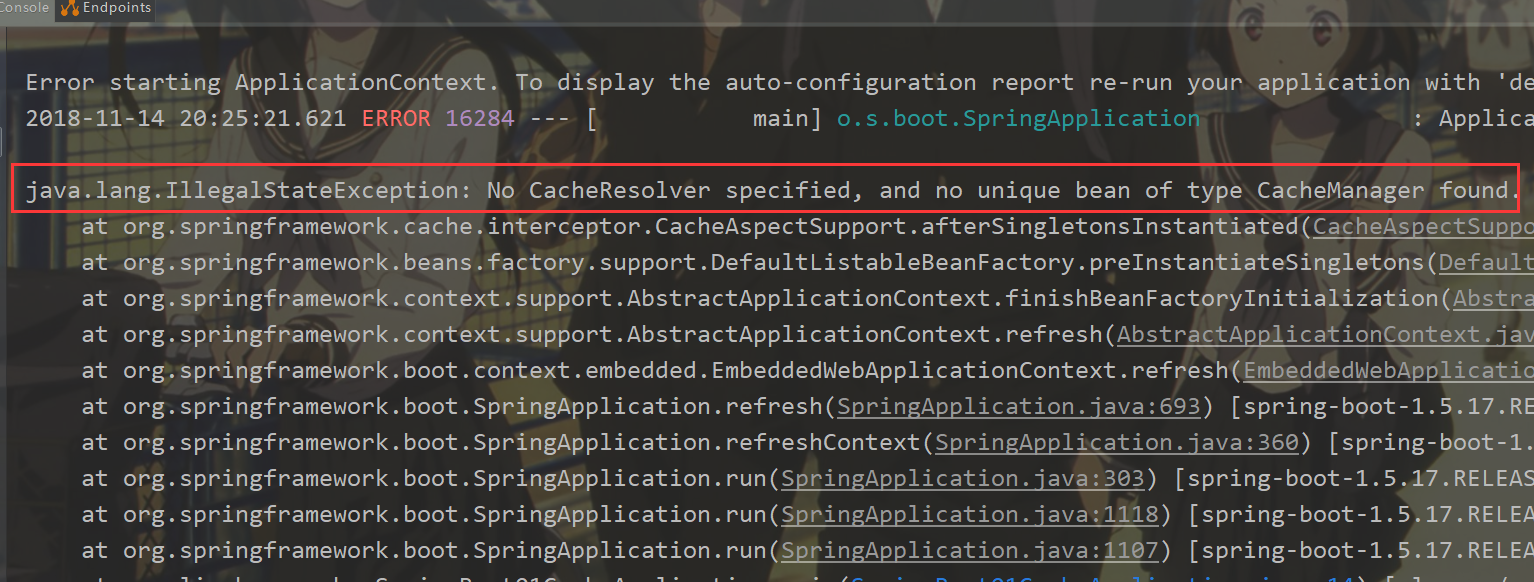
原来是,我们设置了两个CacheManager,需要确定一个默认的CacheManager。所以我们使用默认的CacheManager当做默认的。
在redisConfig中:
@Configuration
public class RedisConfig {
@Bean("employeeRedisTemplate")
public RedisTemplate<Object, Employee> employeeRedisTemplate(
RedisConnectionFactory redisConnectionFactory)
throws UnknownHostException {
RedisTemplate<Object, Employee> template = new RedisTemplate<Object, Employee>();
template.setConnectionFactory(redisConnectionFactory);
Jackson2JsonRedisSerializer<Employee> redisSerializer = new Jackson2JsonRedisSerializer<Employee>(Employee.class);
template.setDefaultSerializer(redisSerializer);
return template;
}
@Bean("departmentRedisTemplate")
public RedisTemplate<Object, Department> departmentRedisTemplate(
RedisConnectionFactory redisConnectionFactory)
throws UnknownHostException {
RedisTemplate<Object, Department> template = new RedisTemplate<Object, Department>();
template.setConnectionFactory(redisConnectionFactory);
Jackson2JsonRedisSerializer<Department> redisSerializer = new Jackson2JsonRedisSerializer<Department>(Department.class);
template.setDefaultSerializer(redisSerializer);
return template;
}
@Bean("employeeCacheManager")
public RedisCacheManager employeeCacheManager(RedisTemplate<Object, Employee> employeeRedisTemplate) {
RedisCacheManager cacheManager = new RedisCacheManager(employeeRedisTemplate);
//设置是否使用前缀,前缀就是cacheNames。
cacheManager.setUsePrefix(true);
return cacheManager;
}
@Bean("departmentCacheManager")
public RedisCacheManager departmentCacheManager(RedisTemplate<Object, Department> departmentRedisTemplate) {
RedisCacheManager cacheManager = new RedisCacheManager(departmentRedisTemplate);
//设置是否使用前缀,前缀就是cacheNames。
cacheManager.setUsePrefix(true);
return cacheManager;
}
//默认的CacheManager,设置优先级最高
//即,当不配置cacheManager="xxxx"的时候,就使用这个缓存管理器
@Primary
@Bean
public RedisCacheManager cacheManager(RedisTemplate<Object, Object> redisTemplate) {
RedisCacheManager cacheManager = new RedisCacheManager(redisTemplate);
cacheManager.setUsePrefix(true);
return cacheManager;
}
}
重启应用:
应用启动成功,没有出错。
在浏览器中输入:http://localhost:8080/empl/1
控制台打印sql语句,是到mysql数据库查询数据
再次访问:http://localhost:8080/empl/1
控制台不打印sql语句,是从redis缓存中取数据。
在浏览器中输入:http://localhost:8080/dept/1
控制台输出sql语句,是到mysql数据库中查询数据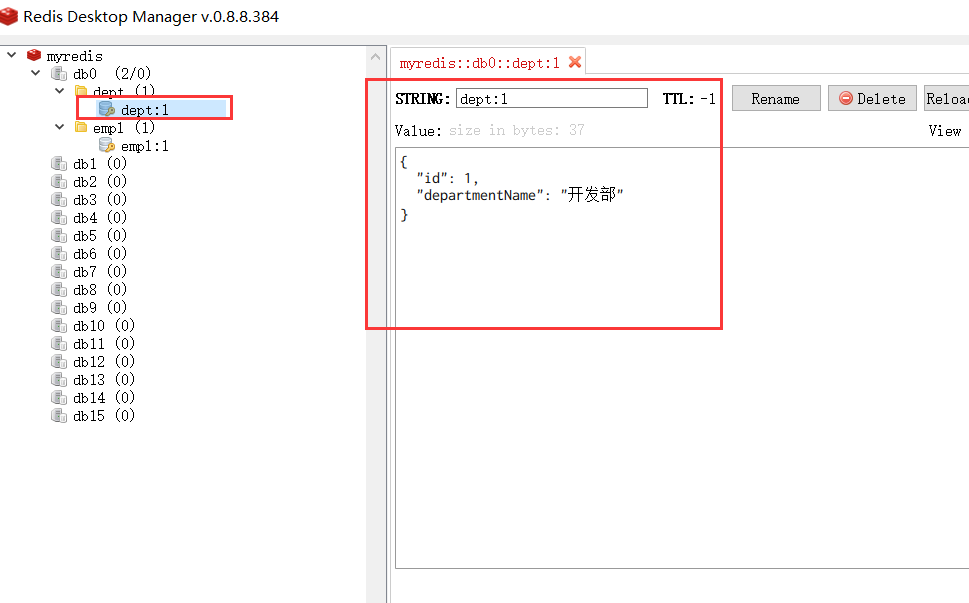
再次访问:http://localhost:8080/dept/1
不报错了,控制台不输出sql语句,是在redi数据库中获取数据。
以上就是整合 redis 到 SpringBoot 中。
使用编码的方式来使用Redis
以上都是使用注解的方式来使用缓存,现在我们来使用编码的方式来操作缓存。
//@CacheConfig(cacheManager = "departmentCacheManager")
@Service
public class DepartmentService {
@Autowired
private DepartmentMapper departmentMapper;
@Autowired
private RedisTemplate departmentRedisTemplate;
//@Cacheable(cacheNames = "dept")
public Department getDeptById(Integer id){
Department department = departmentMapper.getDeptById(id);
departmentRedisTemplate.opsForValue().set("dept"+id,"department");
return department;
}
}
将cahce的注解都注释掉,然后注入departmentRedisTemplate。
自己手动操作缓存。
重启应用,在浏览器中输入:http://localhost:8080/dept/1



